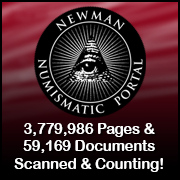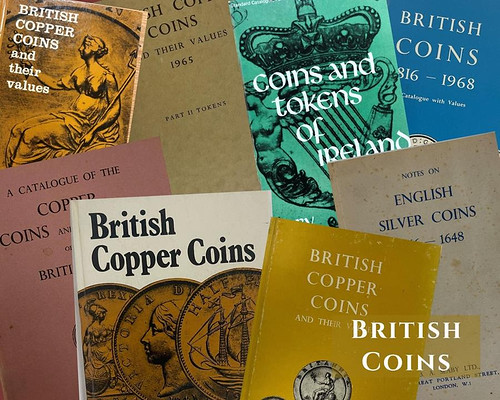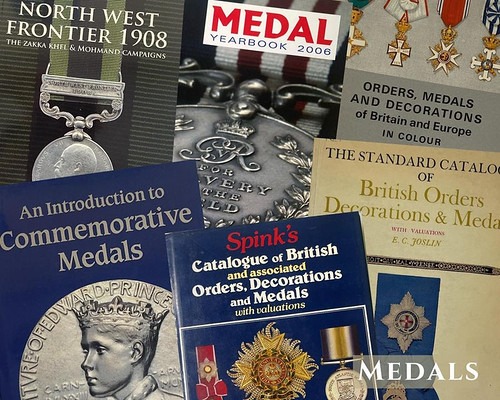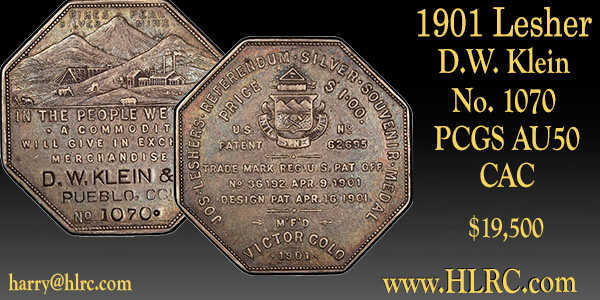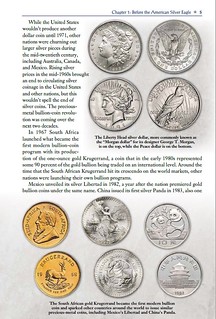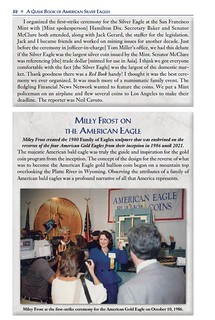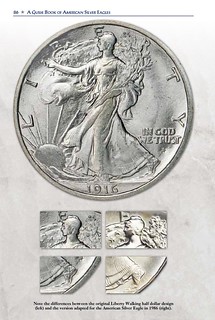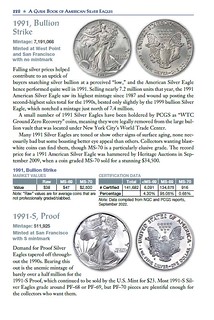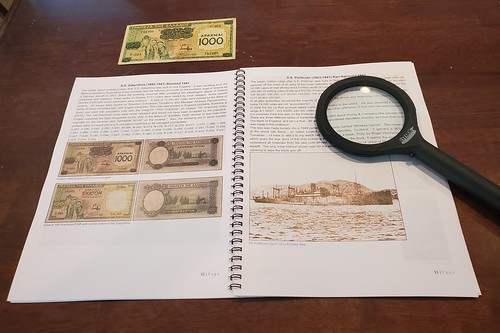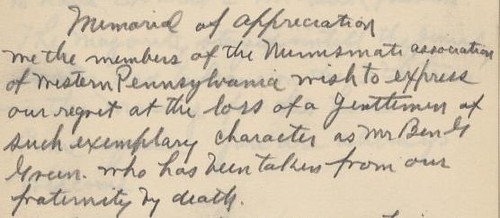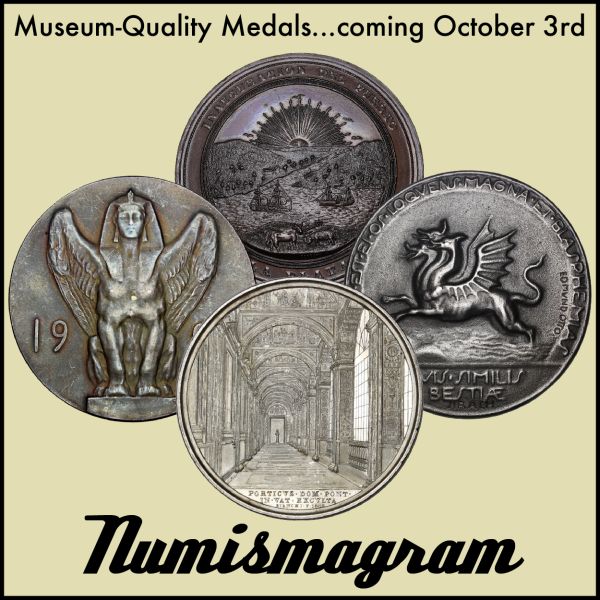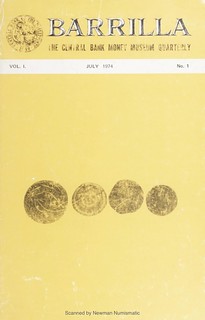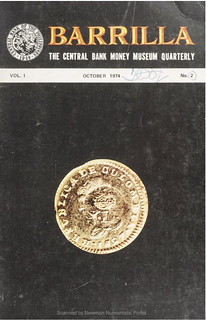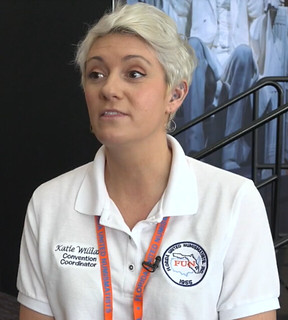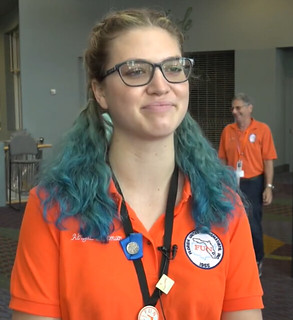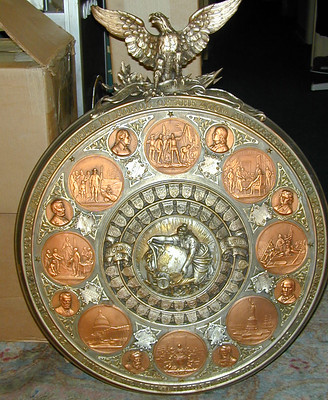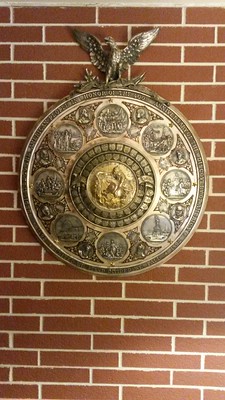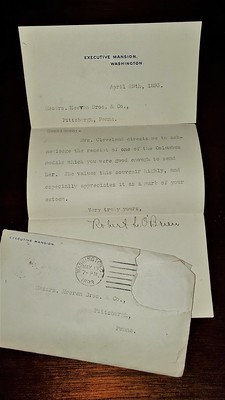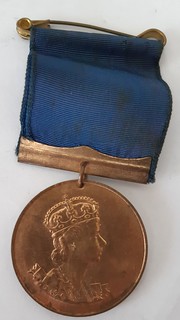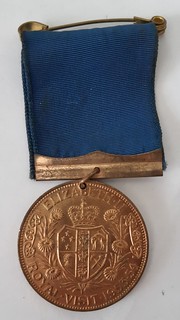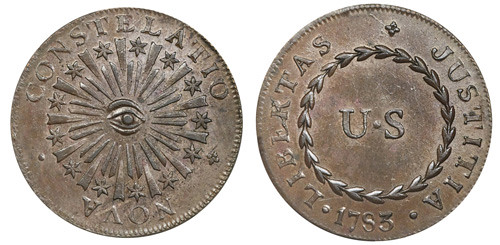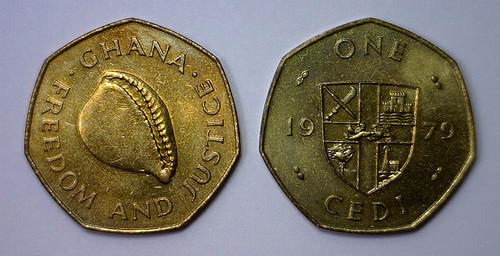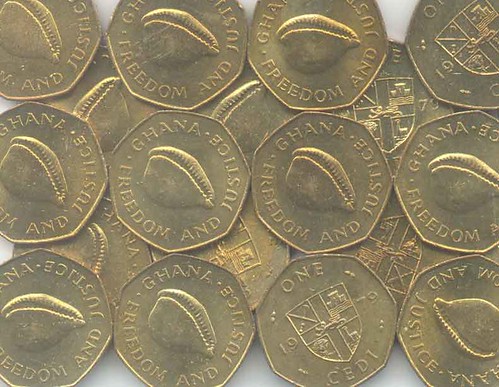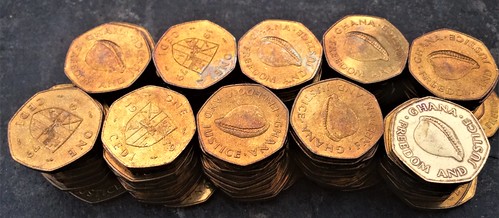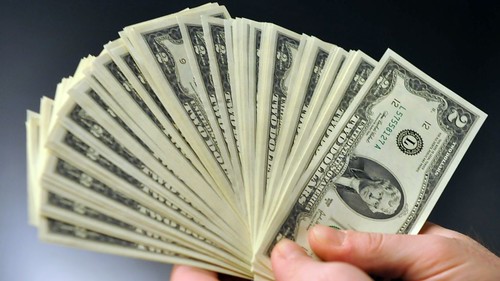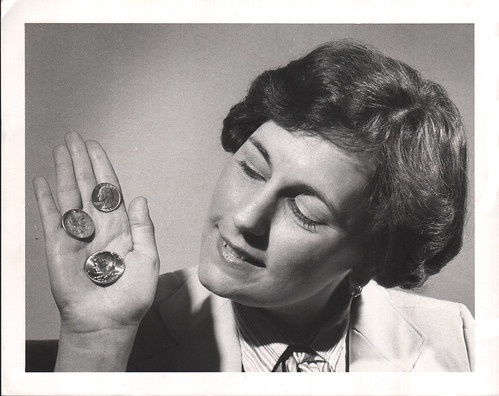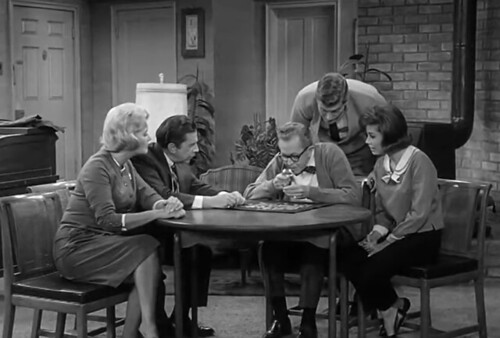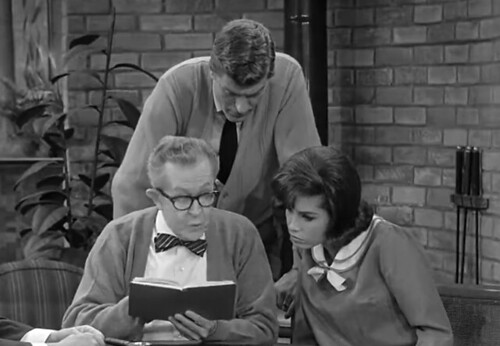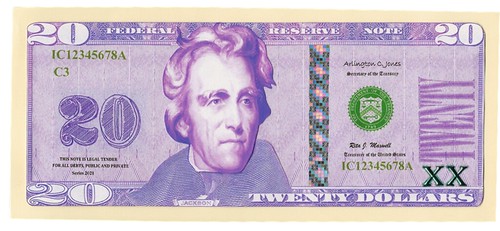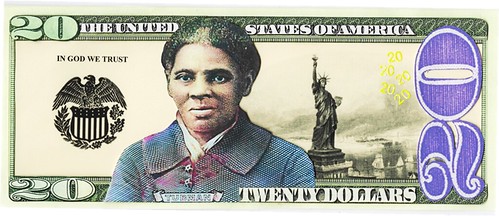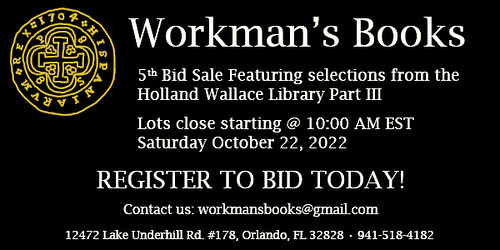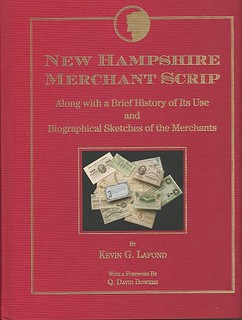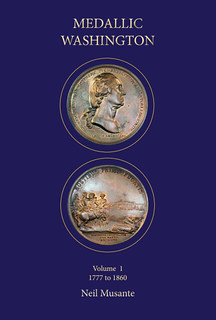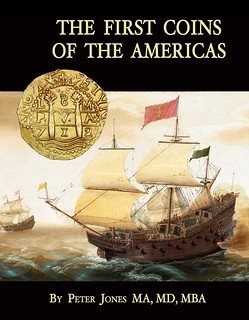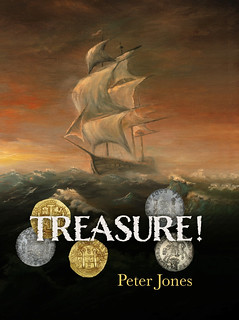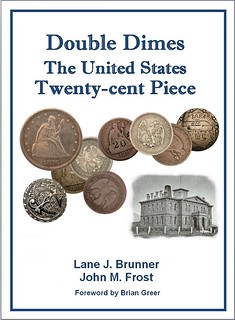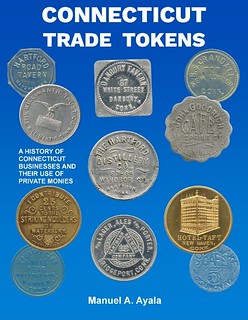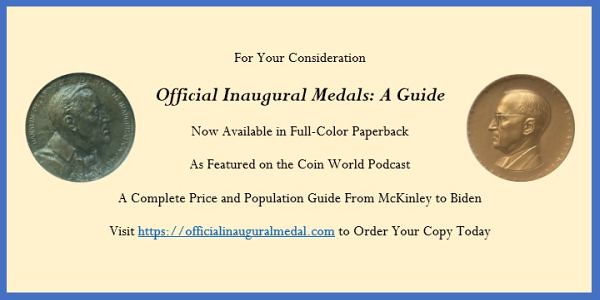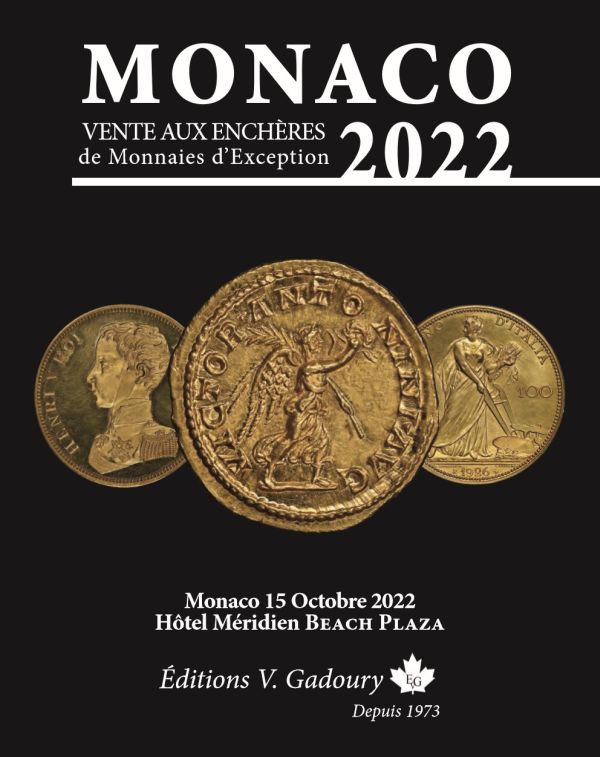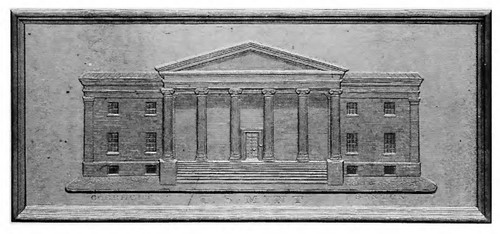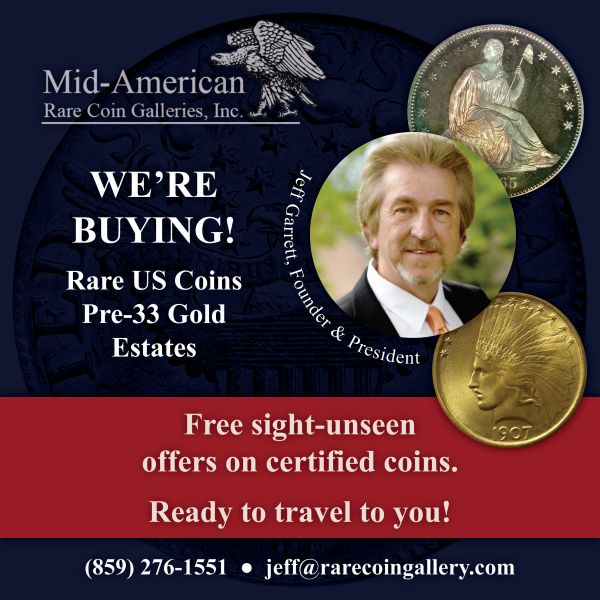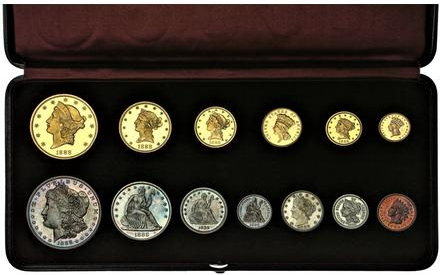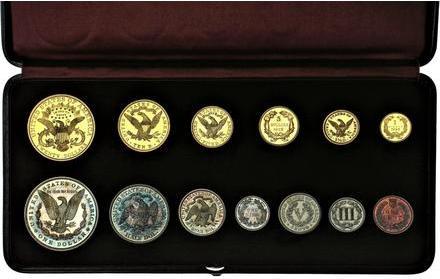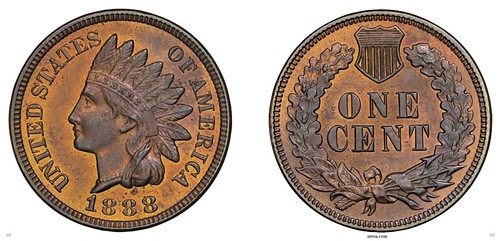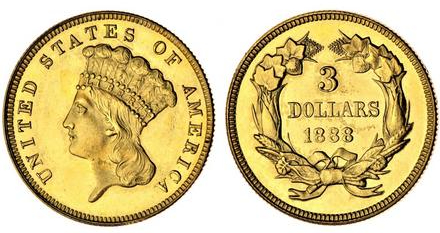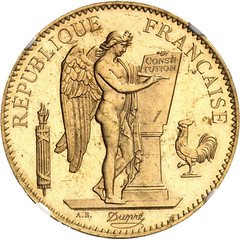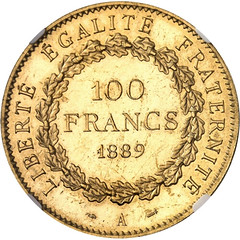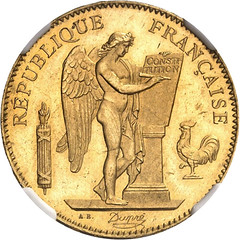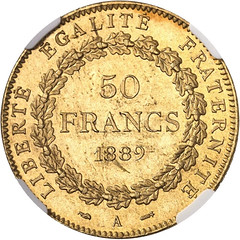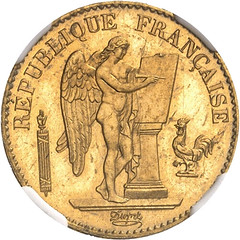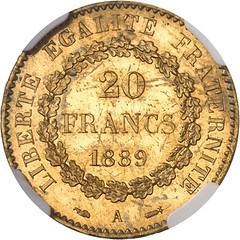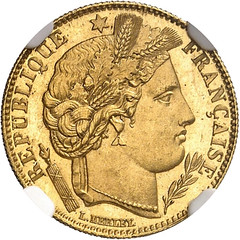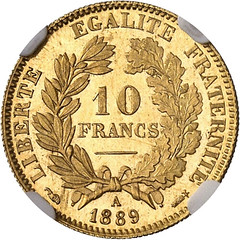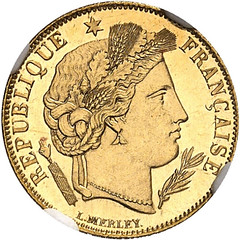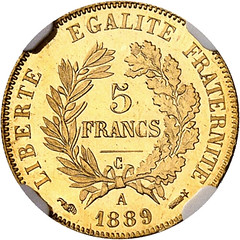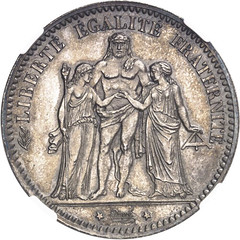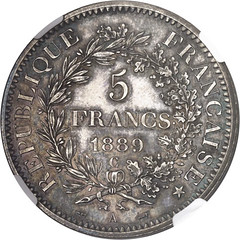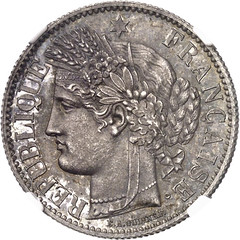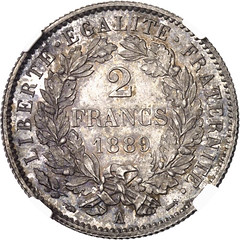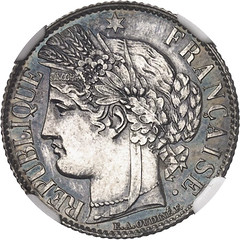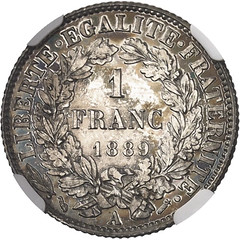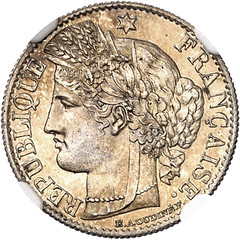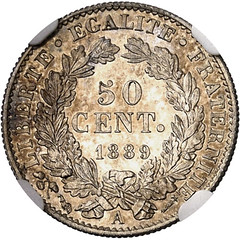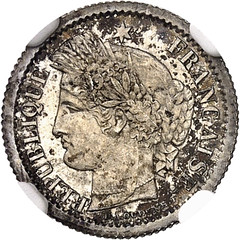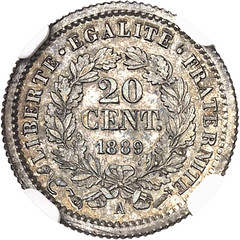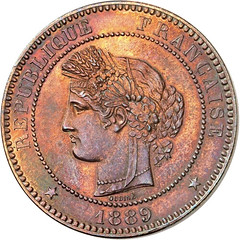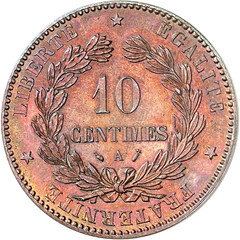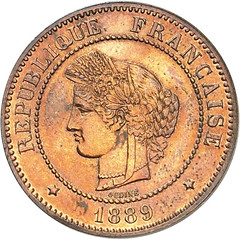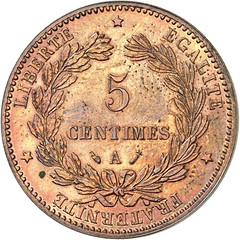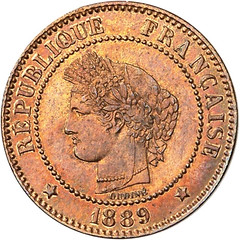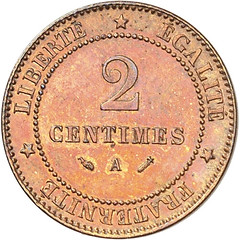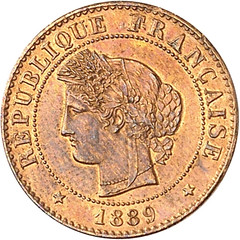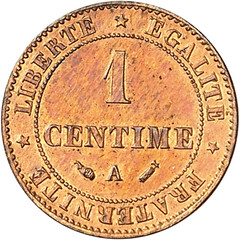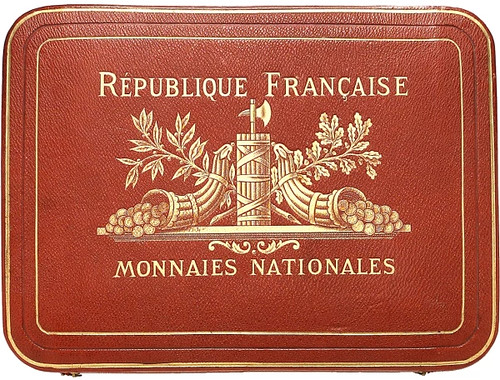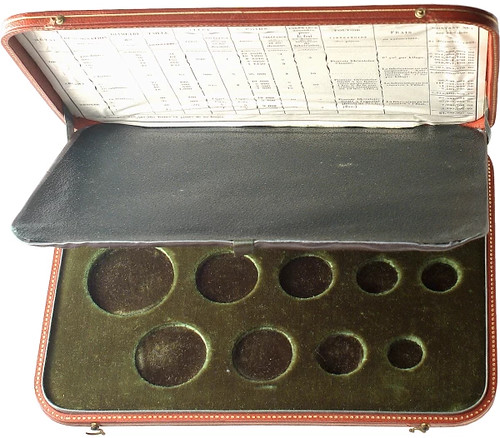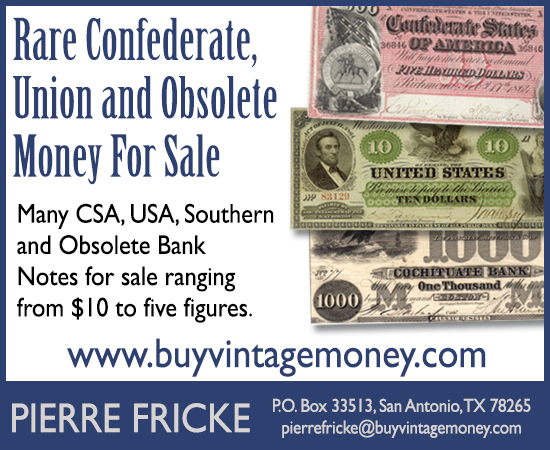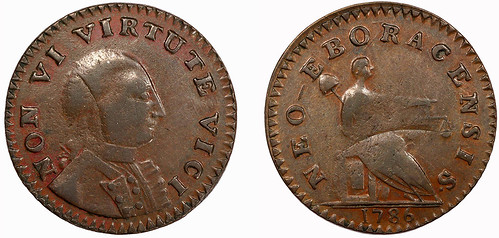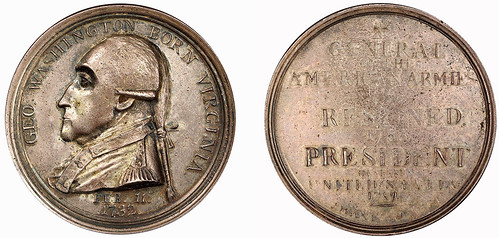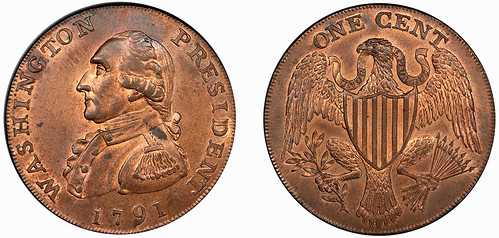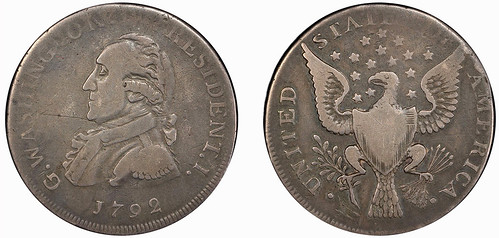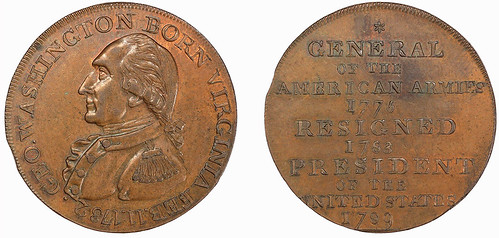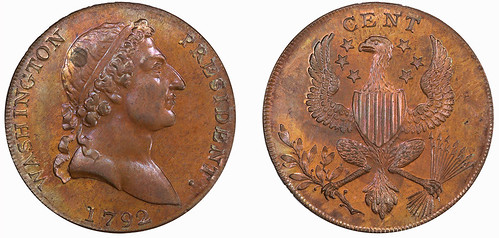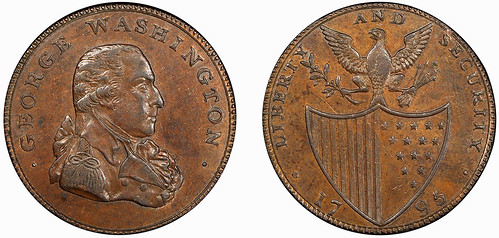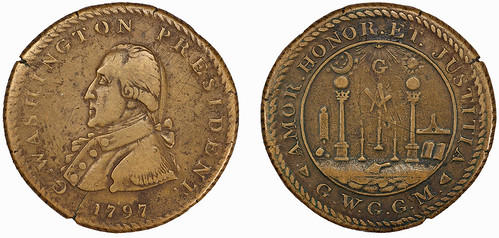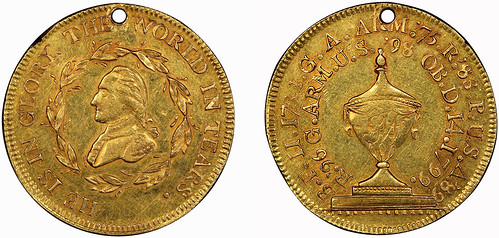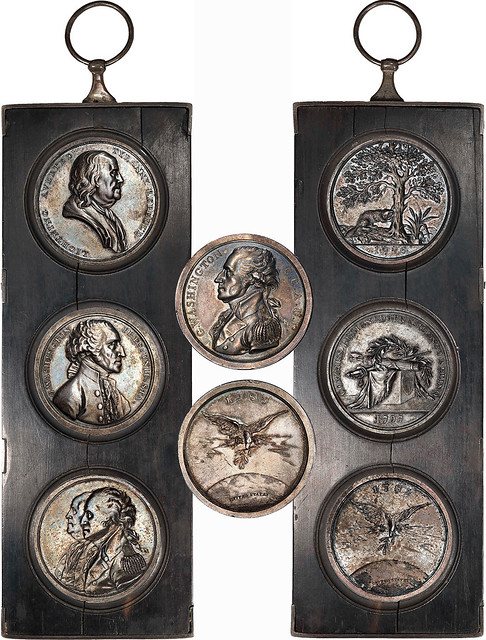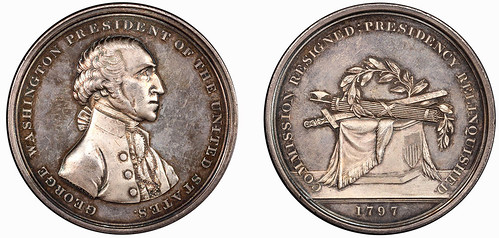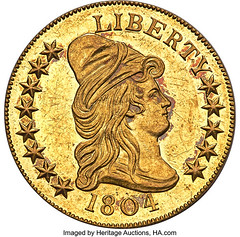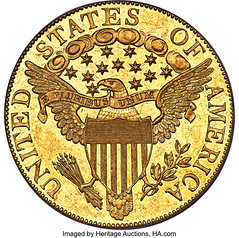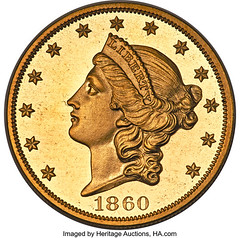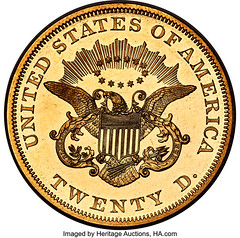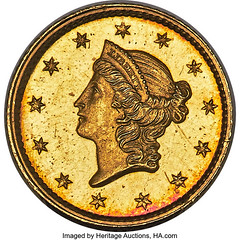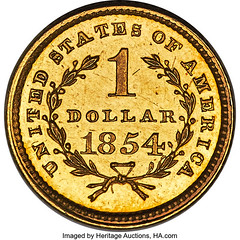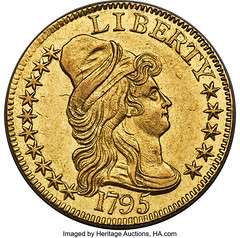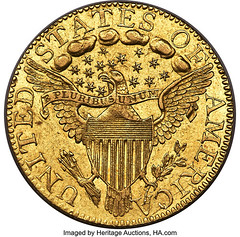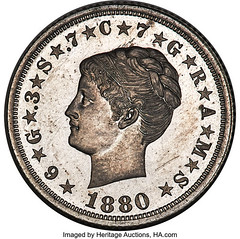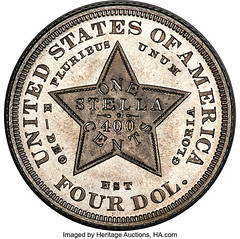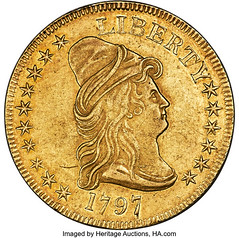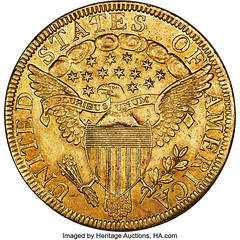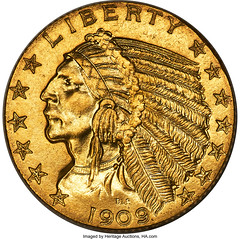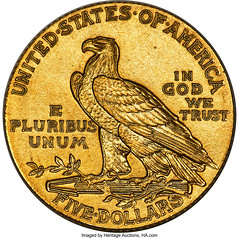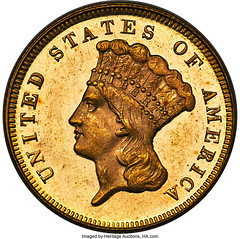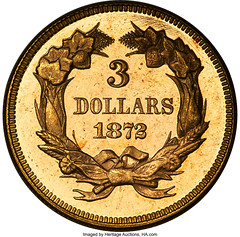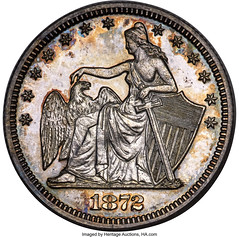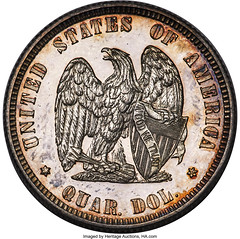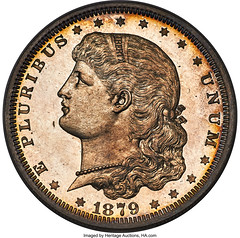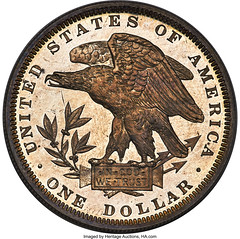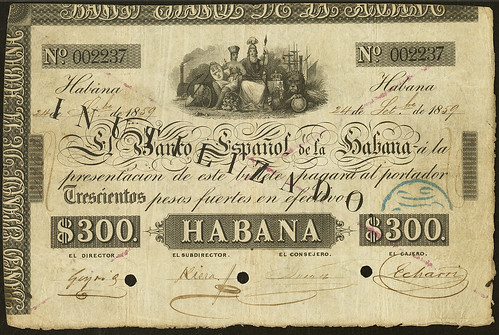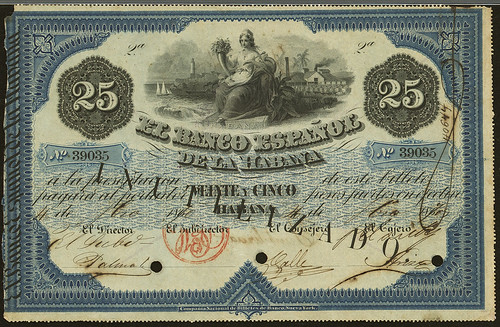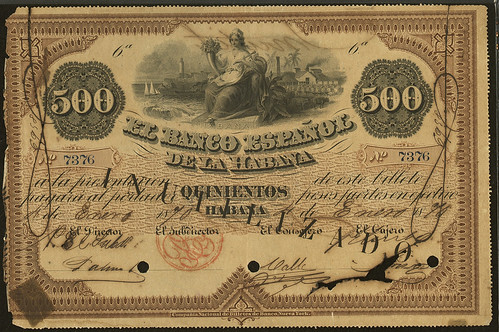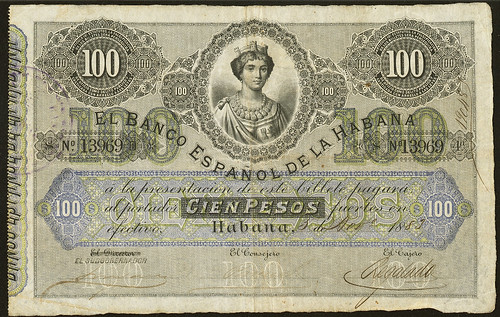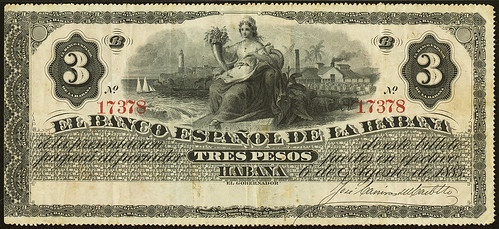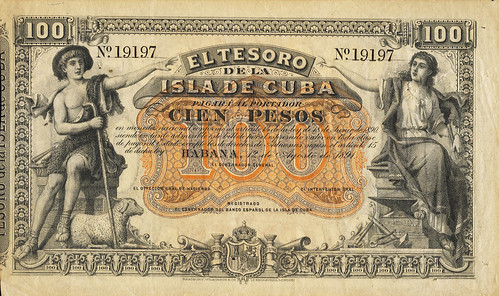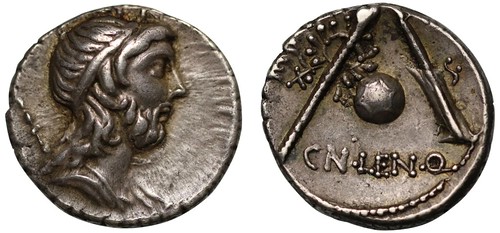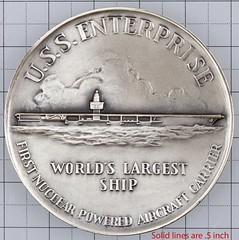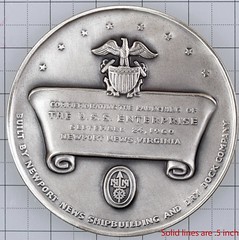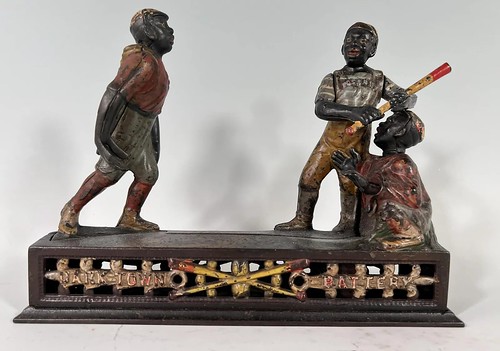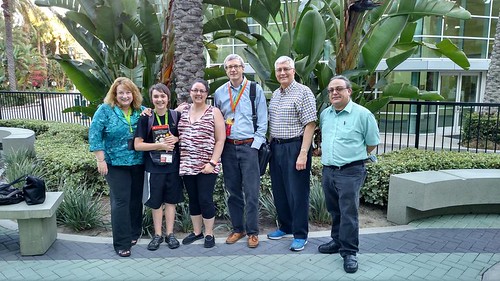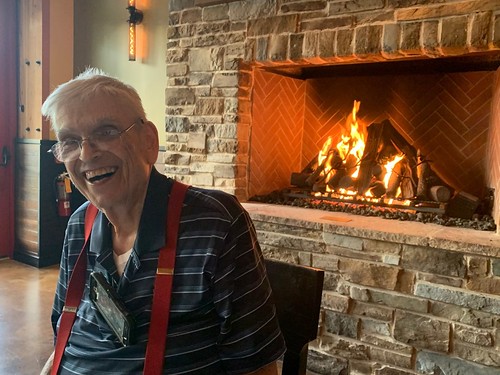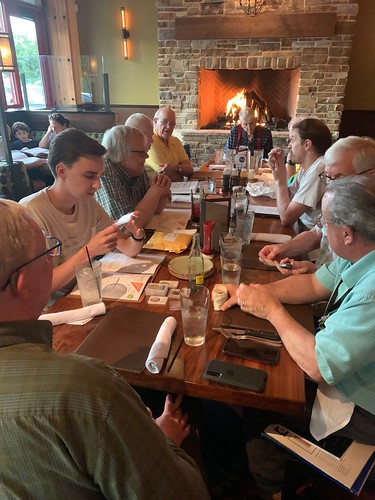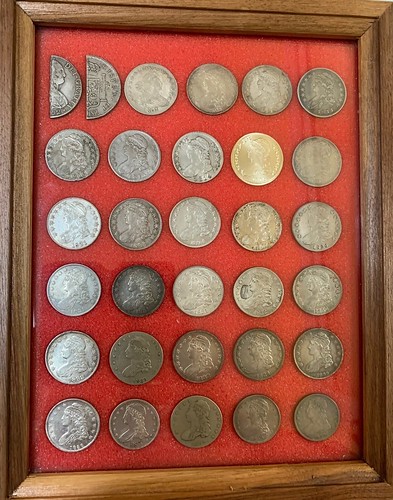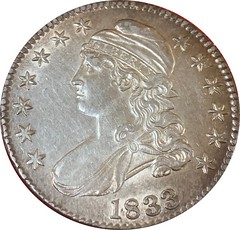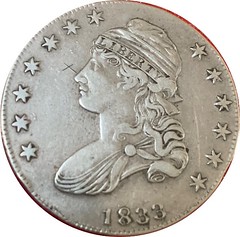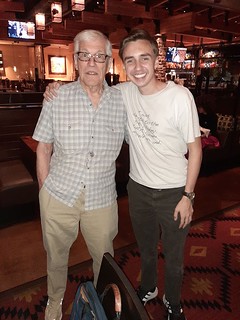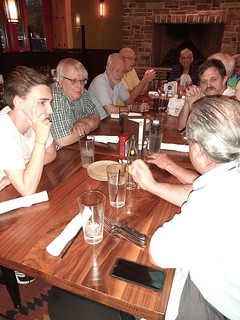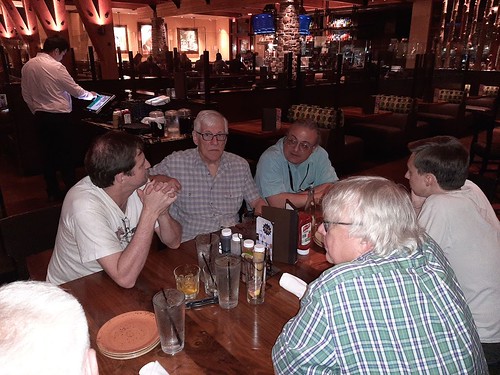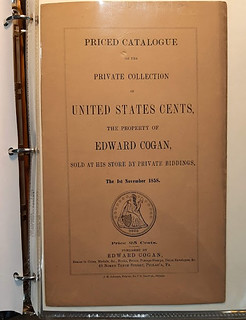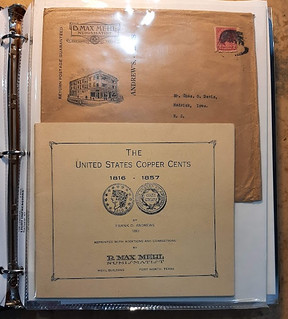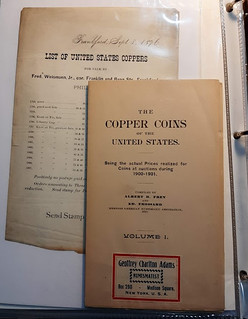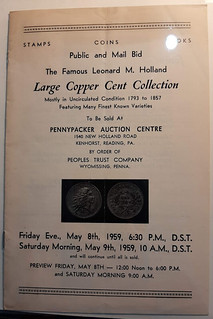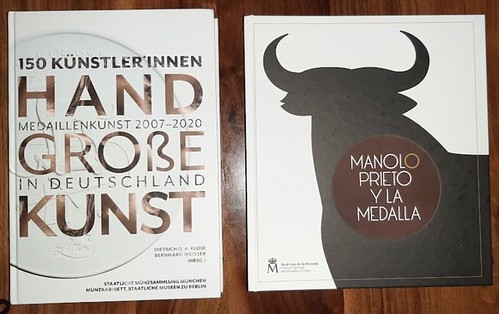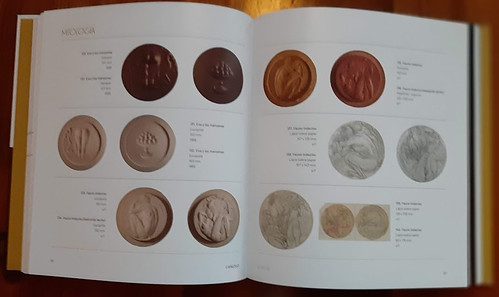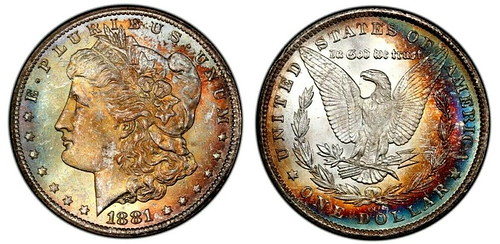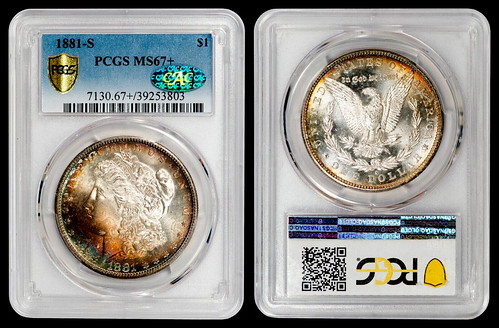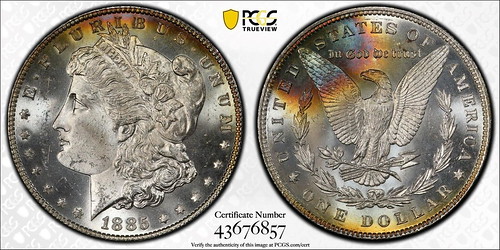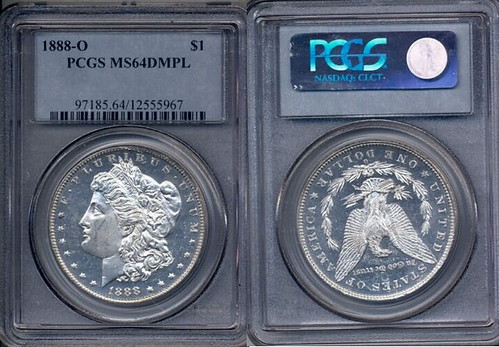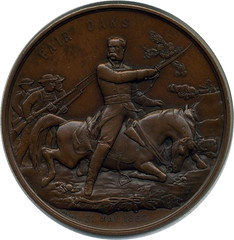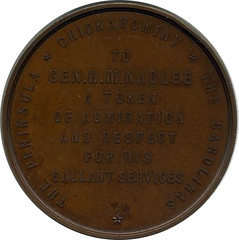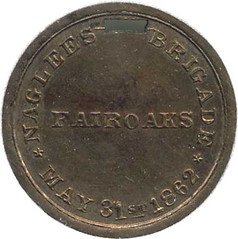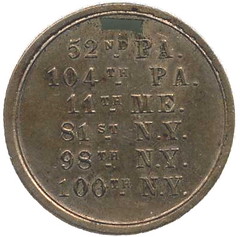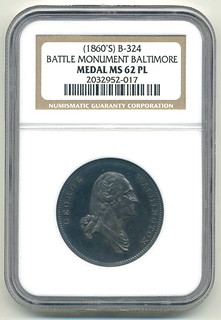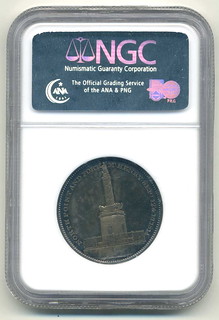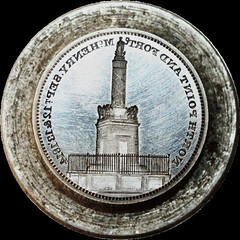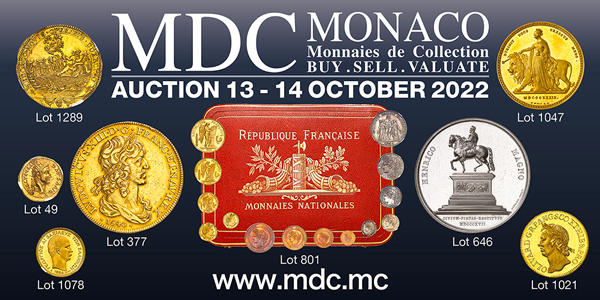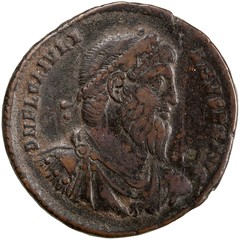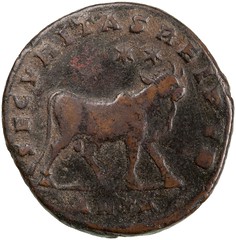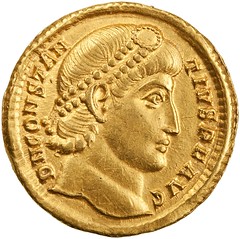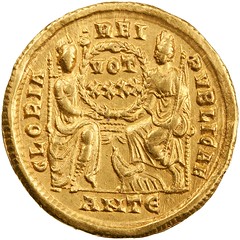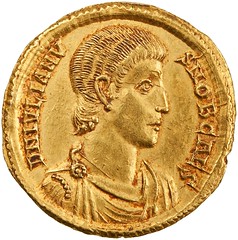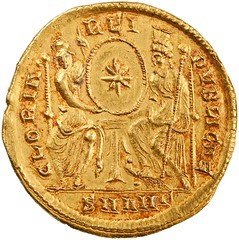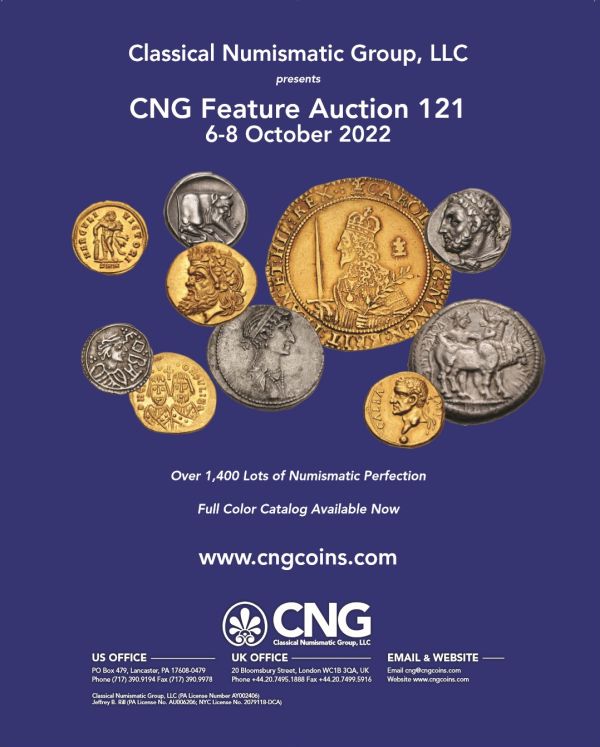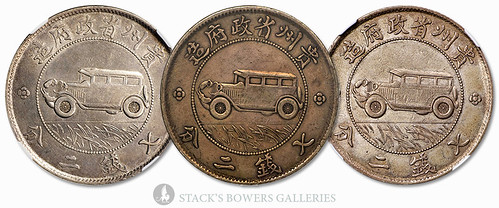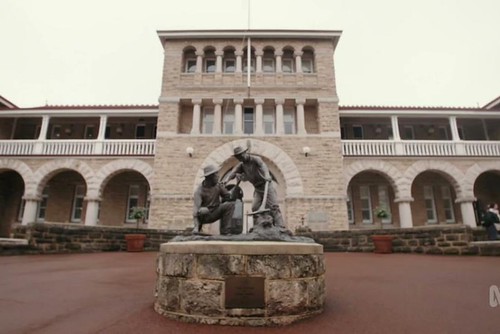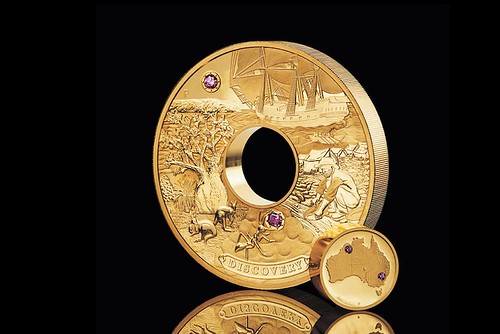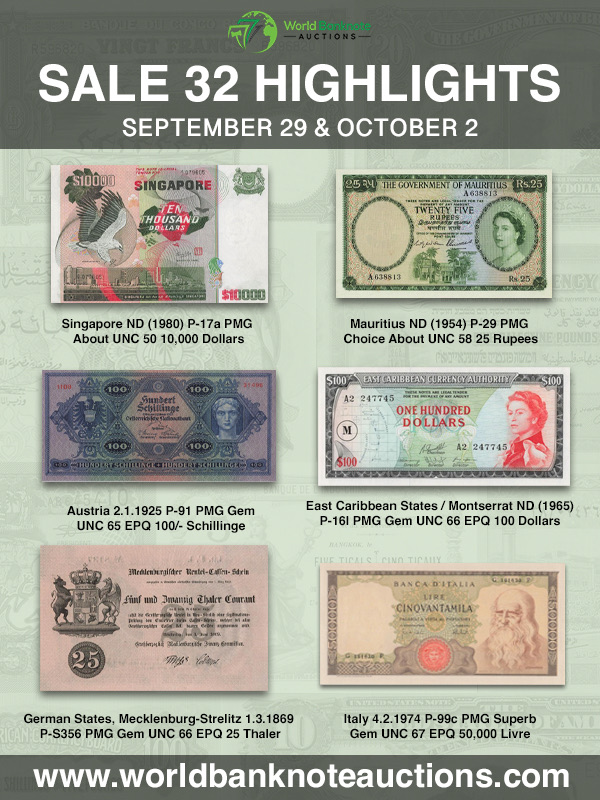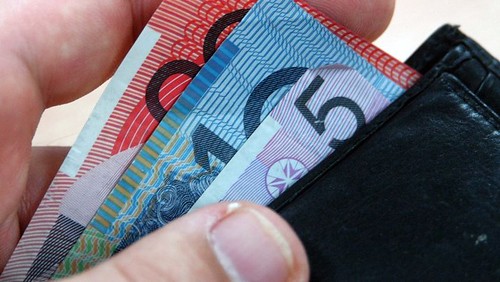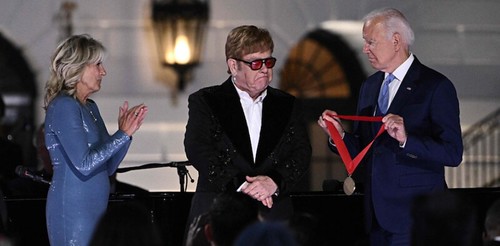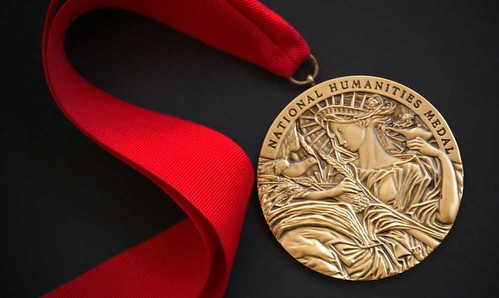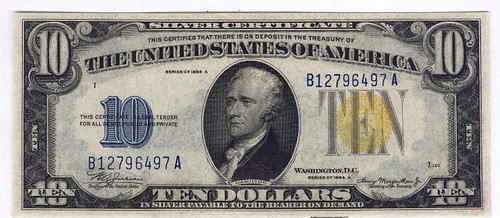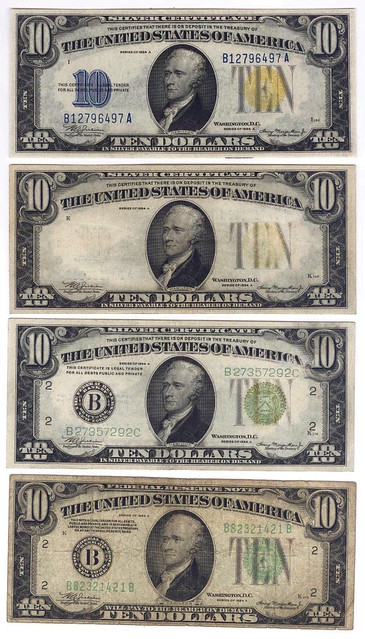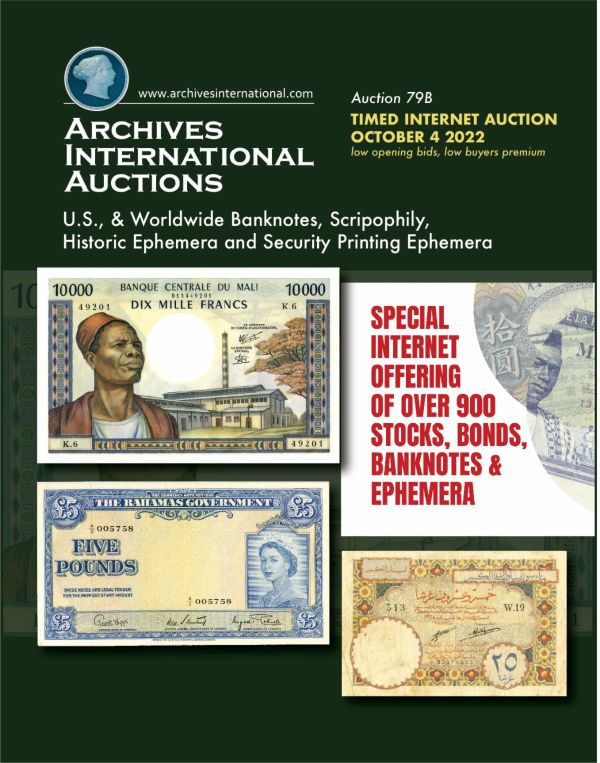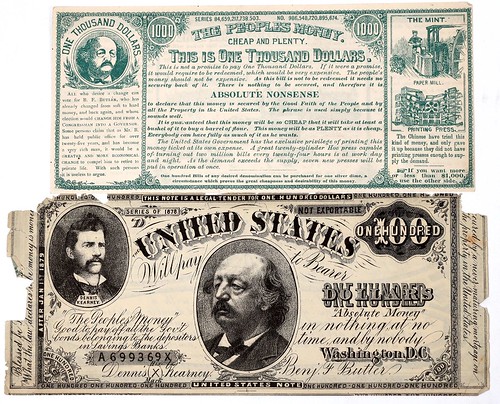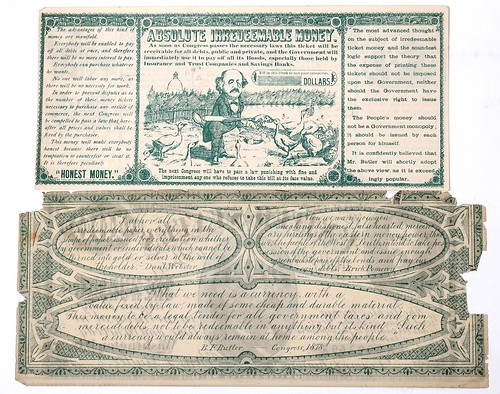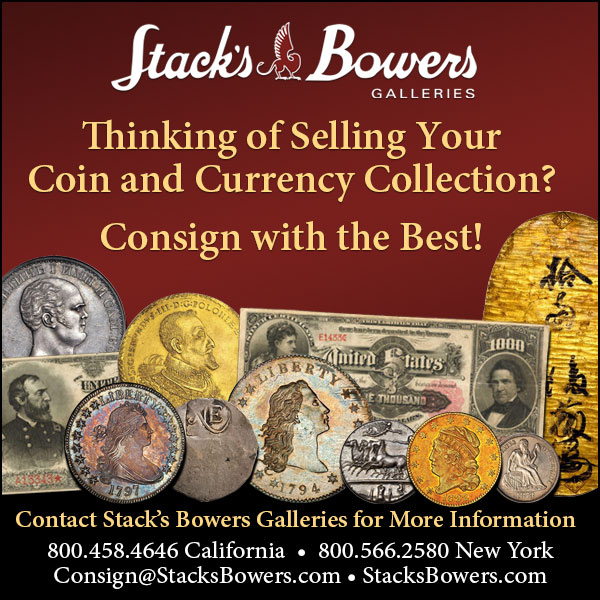
Visit our NBS Sponsors



About UsThe Numismatic Bibliomania Society is a non-profit association devoted to the study and enjoyment of numismatic literature. For more information please see our web site at coinbooks.org SubscriptionsThose wishing to become new E-Sylum subscribers (or wishing to Unsubscribe) can go to the following web page link MembershipThere is a membership application available on the web site Membership Application To join, print the application and return it with your check to the address printed on the application. Print/Digital membership is $40 to addresses in the U.S., and $60 elsewhere. A digital-only membership is available for $25. For those without web access, write to: Charles Heck, Treasurer AsylumFor Asylum mailing address changes and other membership questions, contact Chuck at this email address: treasurer@coinbooks.org SubmissionsTo submit items for publication in The E-Sylum, write to the Editor at this address: whomren@gmail.com BUY THE BOOK BEFORE THE COINSale Calendar |
- WAYNE'S WORDS: THE E-SYLUM SEPTEMBER 25, 2022
- SPINK BOOKS SECOND HAND STOCK
- NEW BOOK: GUIDE BOOK OF AMERICAN SILVER EAGLES
- NEW BOOK: BANKNOTES FROM SHIPWRECKS
- NEWMAN PORTAL ADDS WPNS ARCHIVES
- NNP ADVANCING NUMISMATIC STUDY: BARILLA
- VIDEO: NEW TEAM MEMBERS AT FUN
- HERREN FAMILY COLUMBIA SHIELD LOCATED
- NOTES FROM E-SYLUM READERS: SEPTEMBER 25, 2022
- DICK VAN DYKE SHOW COIN EPISODE
- ARE TWO HEADS BETTER THAN ONE?
- NENA 78TH CONFERENCE BOOK SIGNING EVENT
- VOCABULARY TERM: MAGNIFICATION
- ARTHUR HENRY FRAZIER (1899-2000)
- THE JOHN ROBERT FLETCHER 1888 PROOF SET
- MDC MONACO OFFERS 1889 FRENCH PROOF SET
- SYDNEY F. MARTIN COLLECTION WASHINGTONIA
- HERITAGE OFFERS BASS COLLECTION PART ONE
- HERITAGE OFFERS CUBAN BANKNOTES
- NUMISMATIC NUGGETS: SEPTEMBER 25, 2022
- WAYNE'S NUMISMATIC DIARY: SEPTEMBER 25, 2022
- EMPEROR JULIAN : ARTIFACTS OF APOSTASY
- THE FAMOUS CHINESE AUTO DOLLARS
- AUSTRALIA WATCHDOG INVESTIGATING PERTH MINT
- AUSTRALIAN COIN AND BANKNOTE RISKS
- DONEGAL WAR HERO'S LOST MEDAL FOUND
- ELTON JOHN RECEIVES HUMANITIES MEDAL
- AN ALTERED NORTH AFRICA NOTE
- THE PEOPLE'S MONEY
- LOOSE CHANGE: SEPTEMBER 25, 2022
- FEATURED WEBSITE: NAUTICAL NUMISMATICS
Click here to read the thin version on the web
Click here to subscribe
Click here to access the complete archive
To comment or submit articles, reply to whomren@gmail.com
Content presented in The E-Sylum is not necessarily researched or independently fact-checked, and views expressed do not necessarily represent those of the Numismatic Bibliomania Society.
WAYNE'S WORDS: THE E-SYLUM SEPTEMBER 25, 2022
 New subscribers this week include:
John. Welcome aboard!
New subscribers this week include:
John. Welcome aboard!
Thank you for reading The E-Sylum. If you enjoy it, please send me the email addresses of friends you think may enjoy it as well and I'll send them a subscription. Contact me at whomren@gmail.com anytime regarding your subscription, or questions, comments or suggestions about our content.
This week we open with two new books, updates from the Newman Numismatic Portal, notes from readers and more.
Other topics this week include American Silver Eagles, banknotes from shipwrecks, the Columbia Shield, a comedy show coin episode, magnification and magnifiers, intact 1888 and 1889 proof sets, Washingtonia, auction previews, Chinese auto dollars, the Perth Mint, Elton John's new medal, the People's Money, and nautical numismatics.
To learn more about early 20th century numismatics in Pittsburgh, old-mismatists, new team members at FUN, Indian Peace Medal provenance, James Jarvis and Walter Mould, cowrie on Ghana's coins, Arthur Henry Frazier, Joseph Saxton, the 1792 Getz Pattern Half Dollar, Sansom medals, Cuban banknotes, the Battle of Fair Oaks, Bogus Busties, U.S. Large Cent ephemera, and the Doovis erasure, read on. Have a great week, everyone!
Wayne Homren
Editor, The E-Sylum
SPINK BOOKS SECOND HAND STOCK
Spink is promoting their online stock of used and out-of-print numismatic titles. -Editor
Spink Books has a wide selection of second hand stock newly available for purchase.
From out-of-print Seaby classics to numismatic titles in both English and other languages, please browse our collection
For more information, or to order, see:
https://spinkbooks.com/collections/second-hand-books
https://spinkbooks.com/collections/e-library
NEW BOOK: GUIDE BOOK OF AMERICAN SILVER EAGLES
This press release announces the new Whitman book by Joshua McMorrow-Hernandez on American Silver Eagles. -Editor
 Whitman Publishing announces the upcoming release of A Guide Book of
American Silver Eagles, a new reference and history by Joshua McMorrow-Hernandez. The 384-page book is volume 27 in Whitman's
Whitman Publishing announces the upcoming release of A Guide Book of
American Silver Eagles, a new reference and history by Joshua McMorrow-Hernandez. The 384-page book is volume 27 in Whitman's Bowers Series
of numismatic references. It will debut in
November 2022, available from booksellers and hobby shops nationwide for $29.95. In the
meantime, it is available for preorder (including at www.Whitman.com and online bookstores).
The United States Mint has sold more than 600 million American Silver Eagles since 1986. As a
collectible coin widely admired by hobbyists, the American Silver Eagle has been called the
modern Morgan silver dollar.
It is also the world's most popular silver bullion coin for
investors. Its weight, content, and purity are guaranteed by the government of the United States.
Each American Silver Eagle contains one full ounce of .999 fine silver.
In the Guide Book of American Silver Eagles, award-winning writer Joshua McMorrow-Hernandez offers readers the content they've come to expect from the Bowers Series: behind- the-scenes history; experienced guidance for both collectors and investors; market analysis; and valuable advice on grading, storage, cherrypicking for quality, and other tips for smart acquisition of these popular coins.
The new book includes chapters on the historical context of American silver dollars, other bullion programs of the United States, and the artistic roots of the American Silver Eagle. The largest chapter is a coin-by-coin analysis and market guide with mintages and retail values in multiple grades, including for professionally certified coins. Additional study is given to the series' key dates, varieties, and error coins.
McMorrow-Hernandez interviewed specialists and experts and included insight from the coin's designers, guidance from dealers and collectors, advice for investing, tax and insurance information, storage options, the latest data from the United States Mint, and more.
The American Silver Eagle is not ‘just' a bullion coin,
McMorrow-Hernandez says. It's a
legitimate collectible on every front, including rarity, value, and numismatic challenge.
McMorrow-Hernandez is a widely published author and journalist, and editor-in-chief of FUNTopics, the magazine of Florida United Numismatists. He has written hundreds of numismatic articles for publications including COINage, The Numismatist, Numismatic News, CoinWeek, the PCGS Rare Coin Market Report, Greysheet, The Centinel, Philadelphia Magazine, the Providence Journal, the Tampa Bay Times, and TheFunTimesGuide.com. He is the author of Images of America: The United States Mint in Philadelphia.
In the book's foreword, Q. David Bowers wrote: Whatever your experience level, you have a
talented guide in Joshua McMorrow-Hernandez, who shares insight to help you understand and
appreciate American Silver Eagles. Read and learn from Josh's book, and you can build a
beautiful and valuable collection of your own.
The Guide Book of American Silver Eagles is the 27th volume in Whitman's Bowers Series.
Other authors in the series include Bowers himself, David W. Lange, Richard Snow, Katherine
Jaeger, Roger W. Burdette, Frank J. Colletti, and Rick Tomaska.
A Guide Book of American Silver Eagles, first edition.
By Joshua McMorrow-Hernandez; foreword by Q. David Bowers.
ISBN 0794849792. Softcover, 6 x 9 inches, 384 pages, full color.
Retail $29.95 U.S.
https://whitman.com/guide-book-of-american-silver-eagles/
NEW BOOK: BANKNOTES FROM SHIPWRECKS
Roland Rollins has published a new book. Congratulations! Here's the backstory. -Editor
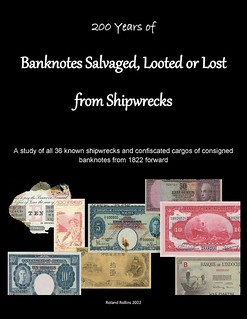 My son Travis and I attended the International Paper Money Show in Kansas City. Travis came back with a banknote paper with the watermark
My son Travis and I attended the International Paper Money Show in Kansas City. Travis came back with a banknote paper with the watermark CSA
for use by the Confederate States of America. The information the dealer passed on was quite compelling. I started researching similar instances of salvaged, looted, confiscated, and lost banknote consignments from the sea.
The work was too large for The Numismatist or the IBNS Journal. The ANA offered to run a 3500 word count version, but I've put too much work to offer only part of the information. After this offer, I made one last look for new findings and found one - the 36th loss. AND, it's the oldest loss recorded - 1822. Yup, exactly 200 years ago and so I had an epiphany and a title. I published the work as a book with the title, "200 Years of Banknotes Salvaged, Looted or Lost from Shipwrecks".
I've posted it for sale on my personal web site for $20 & $25 on Ebay. I would like to thank all those who offered tips and hope the book is an enjoyable read. Maybe some will decide to collect this rather small and unique set of world banknotes.
Here's a link to images, information and ordering with PayPal on my website:
http://currency_den.tripod.com/salvage/salvage.html
Here's a link to the Ebay listing:
"200 Years of Banknotes Salvaged, Looted or Lost from Shipwrecks" book, 2022 | eBay
NEWMAN PORTAL ADDS WPNS ARCHIVES
The latest addition to the Newman Numismatic Portal is a collection of minutes from the Western Pennsylvania Numismatic Society. Project Coordinator Len Augsburger provided the following report. -Editor
Western Pennsylvania Numismatic Society Archives
Housed in five large bins, the Western Pennsylvania Numismatic Society (WPNS) archives are a treasure trove of numismatic history, reflecting the activities of this longstanding organization. Newman Portal has recently scanned one of the minute books, which covers the period 1912-1950. Well-known names such as A. C. Gies and Ben Green appear in the early pages.
The minutes are detailed as to who owned (and exhibited) what, and anyone interested in the holdings of particular members during this period will find ample data. Newman Portal continues to process this important archive, which will appear piecemeal on the site as documents come through the scanning queue.
Image: Ben Green memorial notice, from the February 3, 1914 WPNS meeting minutes
I'm a Life Member of WPNS and a past Curator and President. I wrote a monograph on the early history of the society, but these 20th century records have not been researched and written up. Here are just a few of the entries I noticed while organizing and packing the material for NNP:
"Mr. Clapp - 18 varieties of 1793 cents; Mr. Gies - 4 varieties of 1793 cents; Mr. Locker - sixteen half dimes, 1838 to 1859, uncirculated; Mr. Marks - Pattern half dollars in copper, 2 varieties 1859; Mr Locker - 25 half dimes 1829 to 1873, uncirculated and proof; Mr. Manning - complete set Panama Pacific Commemorative coins 1915; Mr. Gies - Round $50 Gold piece and one Octagon $50 gold piece, $10 dollar gold piece 1854 S Mint; Mr Manning - U.S. Eagle of 1800 Unc. and U.S. Half Eagle of 1804 Unc;" etc.... Amazing stuff.
There is a January 1937 Resolution and copies of correspondence to the ANA that WPNS had asked for the resignation of Howard Gibbs "for good and sufficient reasons" and opposes the appointment of Gibbs as the ANA District Secretary for Western Pennsylvania.
On November 1, 1938 a guest speaker from the U.S. Secret Service spoke about counterfeiting and exhibited "a spurious 1894-S dime".
Ladies and gentlemen - start your numismatic research engines! -Editor
Link to Western Pennsylvania Numismatic Society minute book, 1912-1950:
https://archive.org/details/WPNSBox1-1912meetingminute
NNP ADVANCING NUMISMATIC STUDY: BARILLA
Ken Berger writes:
"I've been communicating with a fellow collector (Alan Peterson) of Philippine CSI notes. Anyway, he sent me a scan of the cover of Barrilla Vol. I, No. 2. I look at it & I email him & tell him that "his" Barrilla has the same markings on the cover (initials & the #2 circled) as mine & that I found it strange. He then tells me that the scan was not of a Barrilla that he owned but rather from the Newman Numismatic Portal & that obviously the scan was of my original Barrilla. He also told me that he does not have a complete hard copy set but, because of the NNP, he is able to have a complete digital set. (I think that there are only 3 complete hard copy sets extant & one of them is held by the Central Bank of the Philippines.)
"I feel good that all our effort to get my complete set of Barrillas uploaded into the NNP is serving a useful purpose & helping to advance the study of Philippine numismatics."
This periodical is one we sought for some time for the Portal. Ken answered the call in The E-Sylum and Len doggedly obtained permission from the publisher, Bangko Sentral ng Pilipinas Money Museum. By the way, the barilla was the first coin struck in the Philippines by Spain in 1728. -Editor
To read issues of Barrilla on NNP, see:
Barrilla: The Central Bank Money Museum Quarterly
(https://nnp.wustl.edu/library/publisherdetail/543561)
VIDEO: NEW TEAM MEMBERS AT FUN
These are selections from the David Lisot Video Library that feature news and personalities from the world of coin collecting. David has been attending coin conventions since 1972 and began videotaping in 1985. The Newman Numismatic Portal now lists all David's videos on their website at:
https://nnp.wustl.edu/library/multimediadetail/522852
Here's one on new team members at FUN. -Editor
New Team Members on Florida United Numismatists Board Offer Fresh Vision.
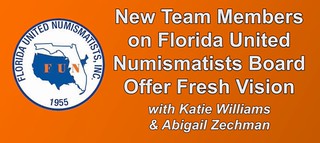 VIDEO: 6:10.
VIDEO: 6:10.
- Katie Williams, Assistant Show Coordinator
- Abigail Zechman, Board Member
David Lisot, Interviewer, CoinTelevision.com. July 8, 2022.
The FUN organization has two bright and vibrant personalities in its ranks. Meet the upcoming new FUN Coin Convention Coordinator, Katie Williams. She will replace Cindy Wibker who will be retiring soon. Another addition is the youngest new Board Member ever elected, Abbie Zechman. Hear what these two young ladies have in store for the Florida United Numismatists organization.
David adds:
"The Florida United Numismatists organization is one of the most successful coin groups in America. Their convention is world class and one of the largest any group. Katie Williams is being groomed to take over as FUN Convention when Cindy Wibker retires. Abbie Zechman is a young numismatist who was recently elected by the FUN membership to the Board of Directors. At 20 years old she is the youngest person to ever hold this title. Hear what these young ladies hope to do for FUN and the hobby of numismatics."
An excerpt of the video is available for viewing on the Coin Television YouTube Channel at:
https://youtu.be/GWNlGaCvaCE
HERREN FAMILY COLUMBIA SHIELD LOCATED
In a June 7, 2015 article a website visitor provided great background information on the magnificent Heeren Brothers Columbia Shields including this first-hand account from family member Alfred Demmler. The earlier article included a photo of a shield provided by Joe Levine. -Editor
"A small number of these shields were imported from Germany by Heeren Brothers Company, (a jewelry store then located at the corner of Penn Avenue and 8th street in downtown Pittsburgh. The motive behind the manufacture of these shields was revealed by the outermost peripheral inscription "dedicated to the American people in honor of the 400th anniversary of the discovery of America,,1892..' Following the actual discovery date...1492...the inscription continues "United we stand.. Divided we fall."
"My maternal grandfather, Fred Mayer (born Sept 17, 1832 in Lauffen on the Neckar River, wurst berg, Germany) created most of the designs for the medallions, shields and plaques, as well as the large eagle at the top of the shield, above another inscription "westward Ho the star of empire makes its way". He transmitted these designs to a metal manufacturing company operated by two of his brothers in Stuttgart, Germany. They produced these shields made of pewter, bronze, copper (filigree), and sheet iron."
"There are 8 large medallions showing various buildings and events in the first 2 or 3 centuries of American history. There is another ring of 8 small medallions depicting four presidents, Washington, Jefferson, Lincoln, Grant, and also four other notable figures, Clay, Morse, Longfellow, and Franklin."
This week a website visitor writes to say that her family is in possession of one of the Columbia shields. They are descendants of Otto Heeren and the shield has been passed down from him. In addition, there is a letter from the White House dated April 29, 1893, on behalf of Mrs. Cleveland, thanking the Heeren Brothers for one of the Columbus medals
... and she values this souvenir highly
.
-Editor
Thanks for the information and photos! It's great to be able to document the existence of another one of these medallic masterworks. -Editor
To read the complete article, see:
HEEREN FAMILY BACKGROUND ON THE COLUMBIA SHIELD
(https://www.coinbooks.org/esylum_v18n23a22.html)
NOTES FROM E-SYLUM READERS: SEPTEMBER 25, 2022
Elizabeth II Coronation Medals: Where Struck?
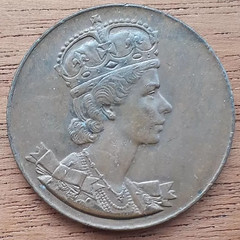 Martin Purdy of New Zealand writes:
Martin Purdy of New Zealand writes:
"I'm intrigued by the note that the item illustrated last week was struck in Canada. A New Zealand item with a slightly smaller version of the same effigy was issued for the 1953-54 visit by the Queen and Prince Philip to NZ and was presented to every schoolchild in the country. We don't have any information on who made it, or where, to my knowledge, so it would be great to have more details on its Canadian origin if at all possible. There's also a British coronation medal with the same obverse."
Above is the Canadian-struck Elizabeth II coronation medallion pictured in last week's article by David Pickup. Below is a New Zealand-struck medal (images provided by Martin). Can anyone provide more information? -Editor
To read the earlier E-Sylum article, see:
COINS OF QUEEN ELIZABETH II
(https://www.coinbooks.org/v25/esylum_v25n38a22.html)
Prucha On Indian Peace Medal Provenance
Researcher and author Larry Lee writes:
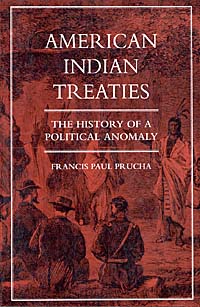 "This note is in response to those searching for more information on individual Native Americans who were awarded Indian Peace Medals (IPMs). As others have noted, the medals can only be attributed on an individual basis. However, there is a great starting point for research: the book American Indian Treaties: The History of a Political Anomaly by Francis Paul Prucha (Univ. of California Press, 1994). (Notice how Prucha gets right to the heart of the issue by calling a treaty between the United States and Indian tribes a ‘political anomaly').
"This note is in response to those searching for more information on individual Native Americans who were awarded Indian Peace Medals (IPMs). As others have noted, the medals can only be attributed on an individual basis. However, there is a great starting point for research: the book American Indian Treaties: The History of a Political Anomaly by Francis Paul Prucha (Univ. of California Press, 1994). (Notice how Prucha gets right to the heart of the issue by calling a treaty between the United States and Indian tribes a ‘political anomaly').
"Appendix B of Indian Treaties lists 367 ratified treaties starting in 1788 between the U.S. government and various native tribes. Each listing records the tribe, date of the treaty, place of signing, the names of the American commissioners and a citation to where the full text of each individual treaty may be found in official governmental records. In some cases, the names of the Native signers can be found on the actual document. An additional 73 treaties from 1872-1911 are listed in Appendix C. Covering 440 treaties, this book is an absolute must for the type of research they are seeking, as it provides the historical context of all IPMs and contains many clues and hints as to recipients.
"Another admittedly rare source of information about awardees are the actual paper certificates that are presented at the same ceremony in which the medal is awarded. I know of five of these certificates in the Nebraska State Historical Society, four signed by William Clark, and there are surely others in other museums. Additionally, in our recent book on the Indian Peace Medals at the Denver Museum of Nature and Science, Steve Nash and I catalog three IPMs that are individualized with personal engravings right on the medal itself. I would be happy to share any information I have with fellow E-Sylum readers.
"While many numismatists will recognize Reverend Prucha because of his book Indian Peace Medals in American History, he is far better known in the academic world for his scholarly works, including the above book on American Treaties as well as The Great Father: The United States Government and the American Indian, which was nominated for a Pulitzer Prize in History in 1985. "
Thank you. Prucha is a great source! -Editor
To read the earlier E-Sylum articles, see:
NEW BOOK: PEACE MEDALS AT THE DENVER MUSEUM
(https://www.coinbooks.org/v25/esylum_v25n15a04.html)
NOTES FROM E-SYLUM READERS: AUGUST 14, 2022 :
On Indian Peace Medal Recipients
(https://www.coinbooks.org/v25/esylum_v25n33a11.html)
NOTES FROM E-SYLUM READERS: AUGUST 21, 2022 : On Indian Peace Medal Provenance
(https://www.coinbooks.org/v25/esylum_v25n34a10.html)
On Minting the Nova Constellatio Coppers
"The September 4th E-Sylum included an excerpt from Greg Reynold's Greysheet series on the Nova Constellatio coppers. I would like to point out that the June 2022 volume of the Journal of Early American Numismatics includes my article about Benjamin Dudley and his possible connection to these pieces (Benjamin Dudley: Maker of the Nova Constellatio Patterns
). With the indispensable assistance of Gary Trudgen and his punch-link analysis, I believe I was able to make a convincing case that the Nova Constellatio coppers were likely the product of business arrangement between James Jarvis and Walter Mould. Evidence of this association is found in a February 1784, Mould-Jarvis letter. At that time, Mould was en route back to England in furtherance of this business, which was undoubtedly coinage related.
"My personal belief is that Robert Morris and Gouverneur Morris were not involved in the minting of the Nova Constellatio coppers. "
Thank you. -Editor
To read the earlier E-Sylum article, see:
NOVA CONSTELLATIO COPPERS, PART 1
(https://www.coinbooks.org/v25/esylum_v25n36a26.html)
Catalog of Stamp Papers Used in British India
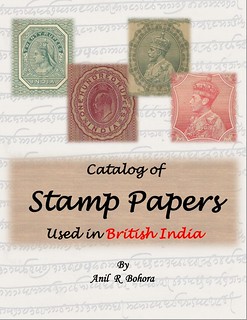 Anil Bohora writes:
Anil Bohora writes:
"Just wanted to let you know that in the first 24 hours over 110 people have accessed the catalog & lists. I am very happy with the response."
Glad to help get the word out! -Editor
To read the earlier E-Sylum article, see:
NOTES FROM E-SYLUM READERS: SEPTEMBER 18, 2022 : Catalog of Stamp Papers Used in British India
(https://www.coinbooks.org/v25/esylum_v25n38a09.html)
The Money Cowrie on Ghana's Coins
"The article says that "By the nineteenth century, money cowries had grown so popular in West Africa that they were used to purchase a third of the human being[s] enslaved and abducted to the Americas."
I believe that to be the case, and is why the Money Cowrie is displayed on Ghana (center of the British Slave Trade for 150 years) coinage with the words Justice & Freedom."
Thanks! Nice coin. Plain, but nice. -Editor
To read the earlier E-Sylum article, see:
MONETARIA MONETA - THE MONEY COWRIE
(https://www.coinbooks.org/v25/esylum_v25n38a16.html)
Tipping With Twos
Bob Fritsch writes:
"I have been using $2 bills for years, mainly as tips. They stand out and people are surprised by them. They are especially effective in restaurants and diners as the wait staff remembers me as The $2 guy
and I tend to get better service. Win-win."
Thanks for the tip! -Editor
To read the earlier E-Sylum articles, see:
TIME TO START PAYING WITH $2 BILLS
(https://www.coinbooks.org/v25/esylum_v25n38a27.html)
WHY DAVE GROHL LIKES $2 BILLS
(https://www.coinbooks.org/v25/esylum_v25n38a28.html)
Susan B. Anthony Dollar Debut Photo
Dave Lange writes:
"I scored another numismatic photo, though I doubt it was intended as such.
"This one shows Robin Haney, Assistant Vice President of Houston's Texas Commerce Bank, comparing the new dollar coin to the quarter dollar and half dollar. Note that the half is a Bicentennial piece.
"The photo was shot by Darrell Davidson for the Houston Chronicle and ran in its July 3, 1979 issue. The SBA Dollars had been released to commerce the day before."
Thanks! -Editor
DICK VAN DYKE SHOW COIN EPISODE
Justin Perrault submitted this description of an old Dick Van Dyke Show episode involving coins. Thanks! -Editor
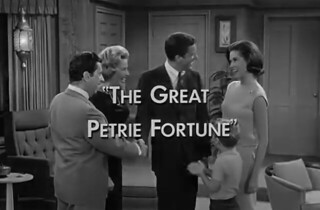 I recall in some past issues discussion of television shows and sitcoms that featured coins, and came across one that doesn't seem to have previously been mentioned in The E-Sylum. I was recently watching an episode of The Dick Van Dyke Show, Episode 133 (Season 5, Episode 7, aired in 1965) entitled "The Great Petrie Fortune". This episode can be watched in its entirety by searching for it on YouTube or at the link provided below.
I recall in some past issues discussion of television shows and sitcoms that featured coins, and came across one that doesn't seem to have previously been mentioned in The E-Sylum. I was recently watching an episode of The Dick Van Dyke Show, Episode 133 (Season 5, Episode 7, aired in 1965) entitled "The Great Petrie Fortune". This episode can be watched in its entirety by searching for it on YouTube or at the link provided below.
The gist of the episode is that Rob Petrie (Dick Van Dyke) inherits an old roll-top desk from his late great-uncle Hezekiah that contains "wealth" of some sort hinted at in a song and video recorded as part of his last will and testament. While rummaging through every drawer and compartment in this desk for the hidden wealth, Rob finds a genie style lamp, inside which contains a collection of coins. This causes Rob and Laura to speculate they may have come across something valuable, since Laura recently read in the paper about a man who sold a penny for $12,000. So Rob suggests they call the Village Hobby Shop for a numismatist (which word they actually use, and which results in a couple of jokes by the "Human Joke Machine" Morey Amsterdam a.k.a. Buddy Sorrell) to inspect their findings, one of which is Rob explaining that a numismatist is a coin expert, and Buddy says that these are old coins so you better get an "old-mismatist".
The numismatist (Mr. Harlow, played by Forrest Lewis) makes a house call and notes a 1909 quarter is worth $20, and at one point you can actually see him referring to an old copy of the Red Book on camera. He tells the Petries that they have a large number of 1913 Buffalo nickels, and if they find the one with the buffalo on the plain instead of the mound a matching set could be worth $20,000. In the end he determines their collection to only be worth about $400, but speculates that if they hold onto it could be worth anywhere from $7,000 to $8,000, by the turn of the century. In the end the truly valuable find was actually an old photograph taken by noted Civil War photographer Mathew Brady of the great-uncle as a baby (he was born in 1863 in Gettysburg) featuring the back of a turned away President Lincoln in the background. All in all a very entertaining episode that I highly suggest all collectors watch, since it deals with the nature of meaningful possessions and what becomes of them when passed to your heirs.It's fun to watch. I'm old enough to remember when the show was broadcast, but didn't recall this episode. I shouldn't feel TOO old, I guess. Dick Van Dyke is still around and doing well at 96, one of the last of the performers from the early days of television. -Editor
https://www.youtube.com/watch?v=8incnRBBcCU (https://www.youtube.com/watch?v=8incnRBBcCU)
ARE TWO HEADS BETTER THAN ONE?
Wayne Pearson poses an interesting solution to the problem of making space for women on U.S. coins and paper money. -Editor
Women on paper money and coins: two heads are better than one
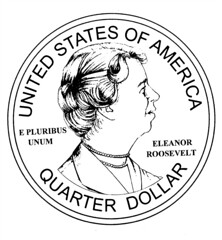 The new quarters using women on the reverse side have their depictions rather small. Here is a thought to
make the reverse of the quarter look like the obverse and making the woman's depiction bigger. I realize it
will end up being a two headed coin-but I can live with that.
The new quarters using women on the reverse side have their depictions rather small. Here is a thought to
make the reverse of the quarter look like the obverse and making the woman's depiction bigger. I realize it
will end up being a two headed coin-but I can live with that.
And in this same vein, why can't we use Harriet Tubman (and others) on the back of the paper money? Here is an example making the back look like the front of the Twenty while still using Jackson on the front. In this series, the twenty is purple. The federal reserve eagle isn't needed, so I removed it. The bill says ‘Federal Reserve Note' and it has the district letter and number. However, I did use the eagle on the back.
References:
Quarter Coin coloring page
(https://www.supercoloring.com/coloring-pages/quarter-coin)
CFA Recommendations for 2014 First Spouse Gold Coin Designs
(https://news.coinupdate.com/cfa-recommendations-first-spouse-gold-coin-designs-3085/)
Souvenir Cards
(https://www.christmasseals.net/index.php/souv)
Coverage: What will the Fed do this week?
(https://talkingbiznews.com/media-moves-and-news/coverage-what-will-the-fed-do-this-week/)
See a Design of the Harriet Tubman $20 Bill That Mnuchin Delayed
(https://www.nytimes.com/2019/06/14/us/politics/harriet-tubman-bill.html)
NENA 78TH CONFERENCE BOOK SIGNING EVENT
Here's the press release for the October 2022 New England Numismatic Association convention, which will include a Young Numismatist program and a book signing with several of New England's numismatic authors. -Editor
NENA 78th Conference and Convention Meets October 15th
On Saturday, October 15, 2022, the New England Numismatic Association will hold its 78th annual Conference and Convention in conjunction with the New Hampshire Coin and Currency Expo at the DoubleTree by Hilton, 700 Elm Street, Manchester, New Hampshire. Ample parking is available at the Center of New Hampshire Parking Garage, with entrances off Elm Street and Granite Street.
There will be a NENA Club table where experts are available to help you identify and estimate the value of your numismatic items. Also available are applications for NENA membership, free publications and opportunities to buy this year's convention medal. The theme for this year's medal is Early New England Windmills
and it pictures one of the dominant smock or skirt design mills. The first wooden windmill in New England was built in 1632, 390 years ago!
A Young Numismatist program will again be held this year on Saturday morning. There will be short talks, quizzes with prizes and lots of giveaways. If health concerns require cancellation, as was the case last year, there will be a place at the NENA table where youngsters will be able to pick up Goodie Bags
full of coins, coin supplies and reading materials and ask questions of the NENA members at the table.
On Friday, October 14th there will be a book signing at the NENA Club table by some of New England's numismatic authors, including Manuel Ayala, John Frost, Peter Jones, MD, Kevin LaFond, Neil Musante and others.
Finally, Numismatic Exhibits have been prepared for your viewing pleasure and education. Be sure to stop by and vote for your favorite.
The mission of the New England Numismatic Association is to encourage and develop the appreciation and understanding of numismatics and the collection of coins and medals; to conduct courses of study in the art and science of numismatics, to give and otherwise sponsor lectures, exhibitions, displays and functions pertaining to the appreciation of the art and science of numismatics.
For additional information go to the NENA website at nenacoin.org and/or the show website www.nhcoinexpo.com
For more information on the New England Numismatic
Association and their show, see:
https://www.nenacoin.org/
To read earlier E-Sylum articles, see:
NEW BOOK: DOUBLE DIMES – THE U.S. TWENTY-CENT PIECE
(https://www.coinbooks.org/esylum_v17n31a02.html)
NEW BOOK: MEDALLIC WASHINGTON
(https://www.coinbooks.org/esylum_v19n32a05.html)
BOOK REVIEW: NEW HAMPSHIRE MERCHANT SCRIP
(https://www.coinbooks.org/v21/esylum_v21n52a05.html)
NEW BOOK: THE FIRST COINS OF THE AMERICAS
(https://www.coinbooks.org/v23/esylum_v23n47a04.html)
NEW BOOK: TREASURE!
(https://www.coinbooks.org/v25/esylum_v25n13a05.html)
NEW BOOK: CONNECTICUT TRADE TOKENS
(https://www.coinbooks.org/v22/esylum_v22n37a05.html)
FALL NEW HAMPSHIRE BOOK SIGNING EVENT
(https://www.coinbooks.org/v25/esylum_v25n32a09.html)
VOCABULARY TERM: MAGNIFICATION
Here's another entry from Dick Johnson's Encyclopedia of Coin and Medal Terminology. -Editor
Magnification. An optical lens or system to magnify the image of the surface of a die, a numismatic or medallic item. Unless an engraver has very good eyes, some form of magnification is used when engraving a die by hand engraving. He has a choice of optical systems to use, ranging from a hand-held lens to a compound microscope. The same is true for anyone who wishes to examine the surface of an existing coin or medal. See chart.
Magnifier – one lens, low power magnification, with or without a handle. Engravers' Magnifier – two plano-convex lens, 3.5 power, provides a corrected, wide, flat field, mounted in hard housing.
Aspheric Magnifier – one lens, 5 power, provides wide field with far edge clarity, mounted on stand or with handle.
Loupe – two or three lens, 3 to 20 power, variety of mountings: for eye (with or without headbands), for spectacles, fold up for pocket, on stand, or with hollow handle for batteries and bulb for illumination.
Optivisor – side-by-side prismatic lens mounted in headband assembly, 1 1/2 to 3 1/2 power, with optional auxiliary lens for additional magnification up to 5 1/4 power, leather adjustable headband.
Telesight – binocular lens on spectacles or clip-on style, 1 to 3 power, flips up when not in use.
Lenscope – three lens, two bulbs for illumination at different angles, 7, 10 or 20 power, lies flat with hands free, can be used with reticles to make measurements in different scales, made by Bausch & Lomb in high quality.
Illuminated Magnifiers – single lens, 1½ power, variety of kinds: on stand or with swing arm, fluorescent lamp often with circular bulb around circular lens.
Microscope – compound with two eyepieces, stereo view, 5 to 40 power, usually with internal lighting.
References:
P2 {1959} Tritt (Donald) Magnification Systems for Coin Study. The Numismatist (February 1959) 72:2 p 131-134.
Dictionaries and encyclopedias are never complete, only as complete as possible at the time of publication. The world and our understanding of it continue to grow and evolve. These are all traditional analog magnifiers - would anyone care to expand on this list for our readers with definitions of digital magnification systems? -Editor
To read the complete entry on the Newman Numismatic Portal, see:
Magnification
(https://nnp.wustl.edu/library/dictionarydetail/516257)
ARTHUR HENRY FRAZIER (1899-2000)
American Numismatic Biographies author Pete Smith submitted this article on author Arthur Henry Frazier. Thanks! -Editor
This week I discovered another numismatic author who lived for more than a hundred years. He has the additional distinction of living in three centuries. His contribution to numismatics is a little off the main path, but still relevant.
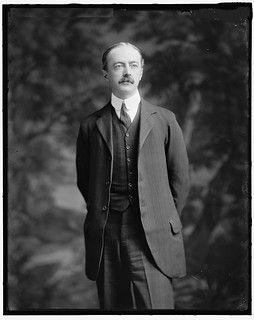 Arthur H. Frazier was born in Manitowoc, Wisconsin, on February 11, 1899, late in the nineteenth
century. His parents were German immigrant Charles Henry Frederick Ernst Frazier (12/18/1855-
1/8/1937) and Clara Zander Frazier (7/17/1863-3/20/1935).
Arthur H. Frazier was born in Manitowoc, Wisconsin, on February 11, 1899, late in the nineteenth
century. His parents were German immigrant Charles Henry Frederick Ernst Frazier (12/18/1855-
1/8/1937) and Clara Zander Frazier (7/17/1863-3/20/1935).
His education was delayed with service in the Army during World War I. He attended the University of Wisconsin and received a B.S. in civil engineering in 1928. He began work as a junior engineer with the United States Geological Survey (USGS) in August 1928.
After an initial assignment in Wisconsin, he was transferred to St. Paul in 1930 and to Washington D. C. in 1935. He designed new equipment to measure the flow of water in rivers and streams. In 1941 he was appointed chief of the Division of Field Equipment. In 1946 he was sent to Columbus, Ohio, as director of the Water Resources Branch Equipment Laboratory. This was renamed he Equipment Development Laboratory. He stepped down as director in 1956.
He retired in 1959 and received a Meritorious Service Award of the Department of the Interior. In retirement he translated works and published new reports on current meters.
In addition to several books on waterflow management, he wrote Joseph Saxton and his Contributions to the Medal Ruling and Photographic Arts, published by Smithsonian Institute Press in 1975.
His final publication in 1978 was U. S. Standards of Weights and Measures, Their Creation and Creators, also published by Smithsonian Institution Press. It is noted that Joseph Saxton was also involved with weights and measures as superintendent of Weights and Measures for the United States Coast Survey.
He died, unmarried, in Madison, Wisconsin, on November 5, 2000, a few months into the twenty-first century. He is buried with his parents at Evergreen Cemetery in Manitowoc.
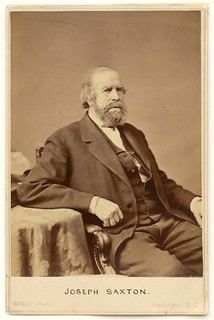 Joseph Saxton was born at Huntington, Pennsylvania. on March 22, 1799, a few months before the end of
the eighteenth century. He married Mary H. Abercromby in 1850.
Joseph Saxton was born at Huntington, Pennsylvania. on March 22, 1799, a few months before the end of
the eighteenth century. He married Mary H. Abercromby in 1850.
He dropped out of school at age twelve to work at his father's nail factory. Then he was apprenticed as a watchmaker but his employer soon died and Saxton moved to Philadelphia seeking employment there. He met Christian Gobrecht and observed Gobrecht's original 1817 attempt at a medal-ruling machine.
While working for Isaiah Lukens in 1828, he built a four-faced clock for Independence Hall. From 1828 to 1837, he was working at the Adelaide Gallery of Practical Science in London, continuing to learn and improve machinery.
Franklin Peale visited London and commissioned Saxton to build a balance scale for the Mint. Saxton returned with the scale to Philadelphia in 1837 and was employed at The U. S. Mint as superintendent of the weighing department.
Joseph Saxton was a pioneer in photography. He read a newspaper account of the process developed by Daguerre and tried it the next day. On October 16, 1939, he took a picture from a window in the Second Mint looking out at Central High School and the State Armory building. The resulting image is the oldest surviving example of a daguerreotype in the United States.
He left the Mint in 1843 to become superintendent of Weights and Measures for the United States Coast Survey and remained there until his death. He produced a set of standard weights and balances for each of the states.
He died at home on October 26, 1873, in Washington, D. C.
Joseph Saxton improved on Gobrecht's medal-ruling machine and reduced distortions to reproduce an image of a medal for reproduction in a book or catalogue.
In this machine, a medal is placed in a horizontal position. A stylus is passed over the surface and the resulting line is cut by a graver into the surface of a horizontal copper plate. The position is changed in small increments forming a series of parallel lines that create the appearance of relief on the copper plate. The image on the plate appears reversed, but when inked and impressed on paper, the image is properly aligned.
Eckfeldt and DuBois used Saxton's third version of the medal-ruling machine, now powered by steam, to produce engravings of coins in the Mint Cabinet for their 1842 book, A Manual of Gold and Silver Coins of All Nations Struck Within the Past Century.
Also illustrated was an image of the Second Philadelphia Mint. Saxton made a daguerreotype of the Mint, Christian Gobrecht made a small relief model, an electrotype shell was made and used in place of a medal. A description of the process is in pages 186-188 of the book.
This marked a brief period of time when a daguerreotype and medal-ruling process were both used to create a printing plate. If photography had developed a decade earlier, it is likely that the medal-ruling technique would never have been used for book illustration.
THE JOHN ROBERT FLETCHER 1888 PROOF SET
I somehow missed the news of this offering, but SPINK has just sold a complete original 1888 U.S. proof set, the last intact one in private hands. Wow! It brought $560,000. -Editor
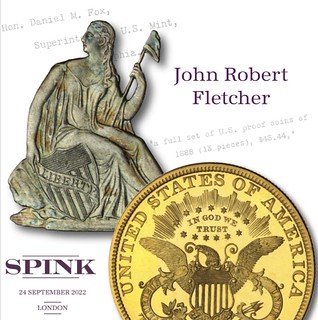 NGC PF64-PF66 CAC | United States of America, An Original "Full Proof Set" of 1888 (13), Twenty-Dollars to Gold Dollar (6), Morgan Dollar to Dime (4), Nickel, Three Cent Nickel and Cent, Philadelphia Mint [13], of the highest rarity as a complete original set, the last known intact set in private hands and matched only by the 'mint fresh' sets held by the American Numismatic Society and Smithsonian Museum, our set unconserved and in beautifully honest original state, further accompanied by contemporary custom fitted case (as at time of issue) embossed in gold Gothic script "John Robert Fletcher", latterly incorporated in a Spink and Son custom case to house the soon-to-be-legendary NGC 'Fletcher' holders.
NGC PF64-PF66 CAC | United States of America, An Original "Full Proof Set" of 1888 (13), Twenty-Dollars to Gold Dollar (6), Morgan Dollar to Dime (4), Nickel, Three Cent Nickel and Cent, Philadelphia Mint [13], of the highest rarity as a complete original set, the last known intact set in private hands and matched only by the 'mint fresh' sets held by the American Numismatic Society and Smithsonian Museum, our set unconserved and in beautifully honest original state, further accompanied by contemporary custom fitted case (as at time of issue) embossed in gold Gothic script "John Robert Fletcher", latterly incorporated in a Spink and Son custom case to house the soon-to-be-legendary NGC 'Fletcher' holders.
To read the complete catalog, see:
https://thewordsmithy.co.uk/client-area/Spink/The_John_Robert_Fletcher_1888_Full_US_Proof_Set/Catalogue.html
To read the complete lot description, see:
22888 - The John Robert Fletcher 1888 Full US Proof Set Auction
(https://live.spink.com/auctions/4-6U0I0Q/22888-the-john-robert-fletcher-1888-full-us-proof-set-auction)
MDC MONACO OFFERS 1889 FRENCH PROOF SET
Here's a great set of lots in the upcoming MDC Monaco sale - an 1889 French proof set complete with the original box. -Editor
Lot 786: Gold 100 Francs
Third Republic (1870-1940). 100 francs Génie, Flan bruni (PROOF) 1889, A, Paris [UNDER FACULTY OF REUNION].
Av. FRENCH REPUBLIC. Winged genius of the Republic standing right, carving word CONSTITUTION on table, flanked by fasces left and rooster right; in the exergue: signatures AB and Dupré. Rev. LIBERTY EQUALITY FRATERNITY. In an oak wreath: 100 FRANCS (date); below (different) (workshop) (different). G.1137 - F.552 - Fr.590; Gold - 32.25 g - 35 mm - 6 h
Top Pop: this is the most beautiful graded example!
NGC PF 66 CAMEO (5790014-014). Burnished blank (PROOF) and cameo effect (CAMEO) with icy fields and matt reliefs. Corner flower.
For the 1889 strikes, the archives are missing and the only information available is given by E. Dewamin (vol. 2, p.327 and note 4). Dewamin is the only one to give a figure of 20 copies for the 5 franc coin. The participation of the Monnaie de Paris in the 1889 exhibition made it possible to strike under the eyes of the public, thanks to a steam pendulum, monetary tokens by A. Borrel. Another monetary press was presented but the coins of 1889 were certainly minted at the Monnaie de Paris and not at the Exhibition.
To read the complete lot description, see:
https://mdc.mc/fr/catalogue/vente-aux-encheres-numismatiques-10/lot-786-7/
Lot 787: Gold 50 Francs
To read the complete lot description, see:
https://mdc.mc/fr/catalogue/vente-aux-encheres-numismatiques-10/lot-787-7/
Lot 788: Gold 20 Francs
To read the complete lot description, see:
https://mdc.mc/fr/catalogue/vente-aux-encheres-numismatiques-10/lot-788-7/
Lot 789: Gold 10 Francs
To read the complete lot description, see:
https://mdc.mc/fr/catalogue/vente-aux-encheres-numismatiques-10/lot-789-7/
Lot 790: Gold 5 Francs
To read the complete lot description, see:
https://mdc.mc/fr/catalogue/vente-aux-encheres-numismatiques-10/lot-790-7/
Lot 791: Silver 5 Francs
To read the complete lot description, see:
https://mdc.mc/fr/catalogue/vente-aux-encheres-numismatiques-10/lot-791-7/
Lot 792: Silver 2 Francs
To read the complete lot description, see:
https://mdc.mc/fr/catalogue/vente-aux-encheres-numismatiques-10/lot-792-7/
Lot 793: Silver 1 Franc
To read the complete lot description, see:
https://mdc.mc/fr/catalogue/vente-aux-encheres-numismatiques-10/lot-793-7/
Lot 794: Silver 50 Centimes
To read the complete lot description, see:
https://mdc.mc/fr/catalogue/vente-aux-encheres-numismatiques-10/lot-794-7/
Lot 795: Silver 20 Centimes
To read the complete lot description, see:
https://mdc.mc/fr/catalogue/vente-aux-encheres-numismatiques-10/lot-795-7/
Lot 796: Bronze 10 Centimes
To read the complete lot description, see:
https://mdc.mc/fr/catalogue/vente-aux-encheres-numismatiques-10/lot-796-7/
Lot 797: Bronze 5 Centimes
To read the complete lot description, see:
https://mdc.mc/fr/catalogue/vente-aux-encheres-numismatiques-10/lot-797-7/
Lot 798: Bronze 2 Centimes
To read the complete lot description, see:
https://mdc.mc/fr/catalogue/vente-aux-encheres-numismatiques-10/lot-798-7/
Lot 799: Bronze 1 Centime
To read the complete lot description, see:
https://mdc.mc/fr/catalogue/vente-aux-encheres-numismatiques-10/lot-799-7/
Lot 800: 1889 Proof Set Box
Third Republic (1870-1940). Original box, National coins (1, 2, 5, 10 bronze centimes; 20 and 50 centimes, 1, 2 and 5 silver francs; 5, 10, 20, 50 and 100 gold francs) 1889, A, Paris [UNDER FACULTY OF REUNION].
Av. FRENCH REPUBLIC / NATIONAL CURRENCIES. On an entablature, a lictor's fasces in the center, accosted by two cornucopias spilling coins, and two branches, laurel and oak, in saltire. Rev. Interior in green velvet, the lid with zipper that reveals the synoptic table of national currencies. - 193 x 145 mm - 12 o'clock
In excellent condition, just a broken clasp. Stunning.
To read the complete lot description, see:
https://mdc.mc/fr/catalogue/vente-aux-encheres-numismatiques-10/lot-800-7/
Lot 801: Lots No. 786 to No. 800 Inclusive
To read the complete lot description, see:
https://mdc.mc/fr/catalogue/vente-aux-encheres-numismatiques-10/lot-801-7/
To read the earlier E-Sylum article, see:
MDC MONACO OCTOBER 2022 SALE
(https://www.coinbooks.org/v25/esylum_v25n37a24.html)
SYDNEY F. MARTIN COLLECTION WASHINGTONIA
Stack's Bowers published this item about Washingtonia in their upcoming sale of the second part of the collection of Syd Martin. Amazing pieces - what a collection! -Editor
Part II of the landmark Sydney F. Martin Collection will feature some of the areas that Syd was most passionate about, including his front line set of 1785 and 1786 Connecticut coppers, French Colonial coinage, Rosa Americana coinage and Washingtonia. The sale will be held during the 2022 Whitman Coin & Collectibles Winter Expo in association with the C4 annual gathering.
The Washingtonia in the Martin Collection is world class, starting with the circa 1777 Voltaire medal
and continuing through the 19th century with many significant highlights. A few are imaged here, but others include a complete set of Seasons medals, numerous funeral medals in silver, copper and white metal, choice Success medals, a fine offering of 1832 issues, exceptional 1889 Inaugural Centennial medals in silver and bronze (the latter a pattern issue), and many more exciting items!
Outstanding Circa 1786 Non Vi Virtute Vici Copper. Musante GW-7. AU-53 (PCGS)
Stunning 1790 Manly Medal in Silver. Musante GW-10. SP-58 (PCGS).
With Contemporary Clamshell Case.
Superb 1791 Large Eagle Cent. Musante GW-15. Lettered Edge.
MS-64RB (PCGS).
Among the Finest Seen.
Very Rare 1792 Getz Pattern Half Dollar. Musante GW-22. SP-10 (PCGS).
With Remarkable Provenance to the 1790s.
Incredible Circa 1792 Washington Born Virginia Copper. Musante GW-33. MS-63BN (PCGS).
From the Norweb Collection.
Prized 1792 Roman Head Cent. Musante GW-21. Proof-64RB (PCGS).
With Provenance to 1895.
Extremely Rare 1792 Washington President / Legend Reverse Copper. Musante GW-35. EF-45 (PCGS).
The Second Finest Known.
Very Rare 1795 Liberty and Security Penny. Musante GW-47. AU-58 (PCGS).
Very Rare 1797 General Grand Master Medal. Musante GW-29. Engrailed Edge. VF-20 (PCGS).
Amazing 1800 Funeral Urn Medal in Gold. Musante GW-70. AU-53 (PCGS).
Joseph Sansom's Complete Four-Piece History of the Revolution Series in Silver. Struck at the U.S. Mint, circa 1805-1808.
Celebrating, Washington, Franklin, The Peace of 1783
and the First Peaceful Transfer of Power, in 1797.
(The three-piece set shown in the holder descended in the Sansom family.)
Unique Circa 1816 Halliday Medal in Silver. Musante GW-57.
SP-62 (PCGS).
With Provenance to 1870.
To read the earlier E-Sylum article, see:
SYDNEY F. MARTIN COLLECTION PART TWO
(https://www.coinbooks.org/v25/esylum_v25n38a15.html)
THE BOOK BAZARRE
HERITAGE OFFERS BASS COLLECTION PART ONE
Here's the press release for the first part of Heritage's offering of the Harry W. Bass Jr. Collection. Images courtesy Heritage Auctions, HA.com. -Editor
After more than a half a century away from the public eye, one of the finest collections of U.S. gold coins and related patterns finally will be made available during Heritage Auctions' Harry W. Bass Jr. Core Collection Part I US Coins Signature® Auction – Long Beach Sept. 29.
Heritage was announced July 13 as the auction destination for this magnificent assemblage, one of the most revered and valuable collections in numismatic history. The collection boasts an estimated value of more than $60 million, and proceeds from its sale will benefit the dozens of Dallas-based nonprofits supported by the Harry W. Bass Jr. Foundation with a particular emphasis on early childhood education and literacy in Dallas.
The collection, which the late Dallas oilman and philanthropist Harry W. Bass Jr. began assembling in the 1960s, has been on display at the American Numismatic Association's Edward C. Rochette Money Museum in Colorado Springs, Colo., since October 2000. Earlier this year, the foundation's trustees voted to sell the collection, which contains some 450 U.S. gold coins dating to the late 1700s, to increase its annual giving, from $2 million to at least $5 million each year, depending on the results of the auction.
Much of this collection was assembled more than half a century ago,
says Todd Imhof, Executive Vice President at Heritage Auctions, and for years was thought to be out of the reach of the collecting community.
When the Bass Foundation announced it would be deaccessioning it to increase philanthropic efforts in our corporate hometown of Dallas, we felt compelled on a personal level to present an auction proposal that the Bass Foundation's trustees would find very enticing and professional. Needless to say, we are thrilled to be awarded the honor of handling the sale of these fabulous coins.
The Bass Foundation's board of trustees hired Professional Coin Grading Service (PCGS) co-founder and numismatics expert John Dannreuther to manage the collection's sale, including selecting an auction house and third-party graders.
Many of the coins in the collection can be traced to the celebrated auction of Louis E. Eliasberg Sr.'s gold coin collection in 1982.
The auction will include more than 100 lots from the Bass Collection, a list that includes:
An 1804 Capped Bust Right eagle, PR63 PCGS, the extremely rare Plain 4 variety, BD-2, JD-1, High R.7. Ex: Woodin-Eliasberg, which Dannreuther called one of the most spectacular gold rarities in the entire American series.
The discovery coin for the issue, it first appeared in a photograph in the August 1869 edition of the American Journal of Numismatics – one of the earliest pictorial representations of any U.S. coinage – and has been a highlight of many famous collections, including those of Lorin G. Parmelee, William Woodin and Louis E. Eliasberg, Sr. before it was acquired by Bass.
An 1860 Liberty double eagle, PR65+ Cameo PCGS. CAC. JD-1, Low R.7, which first surfaced in a B. Max Mehl sale in 1930, after most of the gold proof sets had been broken up. It is one of only seven examples traced of this rare early proof gold issue.
An 1854 gold dollar, PR65 Deep Cameo PCGS. CAC. JD-1, unique – the only Type One Proof example – makes just its second appearance at auction. Bass purchased this coin in 1985 for $68,750, a remarkably high price at the time. It has been off the market ever since, but has been viewed by millions of collectors while on display at ANA Headquarters in Colorado Springs and at major coin conventions.
A 1795 Large Eagle five dollar gold, AU58 PCGS. CAC. Rare BD-14 variety, High R.6 Vibrant surfaces – one of between 14 and 18 examples of which are believed to exist, making BD-14 the second-rarest die pair, with auction appearances often separated by multiple years.
The only proof in private hands of an 1821 half eagle, PR65 Cameo PCGS. CAC. BD-1, JD-1, R.8 as a proof. The 1821 Capped Head Left half eagle is a notable rarity in the series, even in business-strike format; as a proof, it is prohibitively rare. The offered coin is one of just two known examples – the other is included in the National Numismatic Collection at the Smithsonian Institution
An 1880 Coiled Hair stella, PR65 PCGS. Struck in aluminum. Judd-1682, R.8, Ex: Maris-Garrett, one of just four examples traced. Among the in-demand stellas of 1879 and 1880, the 1880 Coiled Hair, with just nine known examples, is particularly coveted. Four exist in aluminum (plus about a dozen in copper), and are about twice as rare as those struck in gold.
Other top lots include, but are not limited to:
A 1797 Large Eagle, BD-3, R.5, AU58+ PCGS
A 1909 Half Eagle PR67 PCGS. CAC
An 1872 Three Dollar, MS65
An 1872 25C Amazonian Quarter Dollar, Judd-1195, Pollock-1335, Low R.7, PR66+ Deep Cameo PCGS. CAC
An 1879 Schoolgirl Dollar, Judd-1608, Pollock-1804, Low R.7, PR67 Cameo PCGS. CAC
Lot viewing for the Core Collection, Part I will be September 27 to 29 in Long Beach, and by appointment at Heritage Auctions' Dallas headquarters.
Images and information about all lots in this auction can be found at HA.com/1353.
HERITAGE OFFERS CUBAN BANKNOTES
Here's a selection of Cuban banknotes in the upcoming October 9, 2022 Heritage sale. Many great rarities here. Images courtesy Heritage Auctions, HA.com. -Editor
Cuba El Banco Espanol de la Habana 300 Pesos 24.9.1859 Pick 2 PMG Choice Fine 15.
The Spanish Bank of Havana was created in 1855 and banknotes from the first series are extremely rare today. This large format 300 Pesos was a middle denomination of the series. All notes issued from this first series in the 1850s were withdrawn in or around 1860, making them virtually impossible to obtain today. All details are clearly legible despite circulation and cancellations. The overprint at front translates to "unusable". Hole punches are mentioned for accuracy. Of the highest degree of rarity, and the first example graded by PMG. An exciting offering and part of a tremendous Cuban collection offered in today's sale.
To read the complete lot description, see:
Cuba El Banco Espanol de la Habana 300 Pesos 24.9.1859 Pick 2 PMG Choice Fine 15.. ...
(https://currency.ha.com/itm/world-currency/cuba-el-banco-espanol-de-la-habana-300-pesos-2491859-pick-2-pmg-choice-fine-15/a/61469-89001.s)
Cuba El Banco Espanol de la Habana 25 Pesos 4.4.1870 Pick 13 PMG Choice Very Fine 35 Net. A simply outstanding colonial type, incredibly rare in any format, and only the third we have offered of this denomination. A fully written date of 4th April 1870 is seen, along with a plethora of other written and printed notations. An interesting stamp on the back is seen between the red cancellation and hole punched cancellations. The font of this note has been overprinted "unusable". Rare in any grade but this is an especially pleasing example which happens to be the single finest of only three currently graded by PMG. Ink burns are mentioned for accuracy.
To read the complete lot description, see:
Cuba El Banco Espanol de la Habana 25 Pesos 4.4.1870 Pick 13 PMG Choice Very Fine 35 Net.. ...
(https://currency.ha.com/itm/world-currency/cuba-el-banco-espanol-de-la-habana-25-pesos-441870-pick-13-pmg-choice-very-fine-35-net/a/61469-89004.s)
Cuba El Banco Espanol de la Habana 500 Pesos 4.1.1870 Pick 17 PMG Fine 12 Net.
A mere two examples of this second highest denomination note are currently graded by PMG. All large format notes of this series are seldom seen and are extremely popular. A plethora of fountain pen ink is seen on both sides of this note, which includes handwritten dates, signatures, and pen and punched cancellations. There are some ink burns, tape repairs and margin damage mentioned, along with stamped cancellations on both sides. Only the second we have offered and part of this stunning series offered in today's comprehensive sale.
To read the complete lot description, see:
Cuba El Banco Espanol de la Habana 500 Pesos 4.1.1870 Pick 17 PMG Fine 12 Net.. ...
(https://currency.ha.com/itm/world-currency/cuba-el-banco-espanol-de-la-habana-500-pesos-411870-pick-17-pmg-fine-12-net/a/61469-89008.s)
Cuba El Banco Espanol de la Habana 100 Pesos 3.11.1883 Pick 23 PMG Very Fine 25.
A crowning banknote featuring a crowned woman at front, this is the first completely original and unaltered example we have offered. 100 Pesos in 1883 was a hefty sum of money representing 20 Spanish crown-sized silver coins of European fineness and weight. The colors and paper are excellent. There is an additional sideways serial number on the front mentioned for accuracy. A high denomination note that is extremely rare as issued and missing from many collections.
To read the complete lot description, see:
Cuba El Banco Espanol de la Habana 100 Pesos 3.11.1883 Pick 23 PMG Very Fine 25.. ...
(https://currency.ha.com/itm/world-currency/cuba-el-banco-espanol-de-la-habana-100-pesos-3111883-pick-23-pmg-very-fine-25/a/61469-89014.s)
Cuba El Banco Espanol de la Habana 3 Pesos 6.8.1883 Pick 28f PMG Very Fine 25.
The 1 and 3 Pesos banknotes issued from 1872 to feature a standard design with three elements: Havana Harbor, a tobacco plant, and on the back, Christopher Columbus with his men approaching land. All design elements are on full display, as this circulated example has remained bright and fresh. At the time of cataloging, this is the first and only example graded by PMG. Very rare in issued form and a delightful banknote from the 19th century.
To read the complete lot description, see:
Cuba El Banco Espanol de la Habana 3 Pesos 6.8.1883 Pick 28f PMG Very Fine 25.. ...
(https://currency.ha.com/itm/world-currency/cuba-el-banco-espanol-de-la-habana-3-pesos-681883-pick-28f-pmg-very-fine-25/a/61469-89023.s)
Cuba El Tesoro De La Isla De Cuba 100 Pesos 12.8.1891 Pick 43r Remainder PMG Very Fine 25. Pinholes are mentioned.
To read the complete lot description, see:
Cuba El Tesoro De La Isla De Cuba 100 Pesos 12.8.1891 Pick 43r Remainder PMG Very Fine 25.. ...
(https://currency.ha.com/itm/world-currency/cuba-el-tesoro-de-la-isla-de-cuba-100-pesos-1281891-pick-43r-remainder-pmg-very-fine-25/a/61469-89049.s)
NUMISMATIC NUGGETS: SEPTEMBER 25, 2022
Here's a selection of interesting or unusual items I came across in the marketplace this week. Tell us what you think of some of these. -Editor
Roman Republic, Cn. Lentulus, silver Denarius, Spanish mint (?) 76-75 BC, bust of the Genius Populi Romani right, sceptre over shoulder, [GPR above],rev.wreathed sceptre, globe and rudder, EX left, S[C] right, CN LEN Q below, 3.89g (Cr. 393/1a; Syd. 752; RBW 1433). Extremely fine.
The type associates Rome with domination abroad, over land and sea.
From the online stock of Sovereign Rarities. -Editor
To read the complete item description, see:
Cornelius Lentulus, silver Denarius
(https://www.sovr.co.uk/products/cornelius-lentulus-silver-denarius-gm27243)
Medallic Art Co. of New York issued this .999+ fine silver medal to commemorate the christening of the nuclear-powered aircraft carrier Enterprise at Newport News, Virginia, on September 24, 1960. In original box with paperwork. Designed by Ralph J. Menconi, 63 mm, 4.7 oz.
I wasn't familiar with this Medallic Art Co. medal. Menconi's done better work, but he was probably constricted by the customer's requirements, resulting in a wordy reverse. Sorry, Trekkies - it's not YOUR Enterprise. From the October 15, 2022 Holabird sale. -Editor
To read the complete lot description, see:
U.S.S. Enterprise Official Launching Silver Medal [157927]
(https://www.icollector.com/U-S-S-Enterprise-Official-Launching-Silver-Medal-157927_i46434429)
Cast Iron Mechanical Bank, Dark Town Battery, J & E Stevens Company, patented January 17, 1888, with original paint.
Dimensions: 7.5 x 9.75 x 2.75 in.
Condition: Normal wear to painted surface. Good working condition.
To read the complete lot description, see:
Cast Iron Mechanical Bank, Dark Town Battery
(https://www.liveauctioneers.com/item/136194612_cast-iron-mechanical-bank-dark-town-battery)
WAYNE'S NUMISMATIC DIARY: SEPTEMBER 25, 2022
Wayne Herndon was the host for the September 20, 2022 meeting of my northern Virginia numismatic social group, Nummis Nova. He chose the Lazy Dog Restaurant & Bar at Fair Oaks Mall in Fairfax. I arrived around 6pm and several folks were already seated, including Wayne, Eric Schena, Jon Radel, Chris Neuzil and Mike Packard. I took a seat at the far end of the table near Eric and Jon, saving a seat for my guest Kellen Hoard who'd arrived in D.C. from the Seattle area to begin his freshman year at George Washington University.
The head of the table was in front of a blazing hot fireplace where Tom Kays and Julian Leidman took their seats. Steve Bishop and Dave Schenkman soon arrived and before long Kellen was there, too. I introduced him to the group although he already knew Julian and Eric. Eric was present when I had my first dinner with Kellen, his Mom Cathy Webb, Len Augsburger, his wife Debra Kurtz, and Joel Orosz during the 2016 ANA in Anaheim, CA. I met Kellen before the start of an NBS meeting thinking, "Disneyland is across the street and this kid wants to be here with us coin book geeks??? He's one of us!!!" I asked him if he and his Mom had plans for dinner and quickly arranged an outing. Here's my photo of the group before we headed to the restaurant. See my ANA Diary article (linked below) for more. A memorable convention.
Tom Kays wrote up this account of the Nummis Nova dinner, headlined in the classical style "NVMMIS NOVA". Thanks!
Tom's Take on the September 2022 NVMMIS NOVA Dinner
At the far end of the table, though it was a warm, dusky night in late summer, a great fire was blazing in the gas fireplace just inches away from poor Julian who said he didn't mind the roasting, but soon asked the wait staff to turn down the heat as he was half toasted with this rustic ambiance. We chilled out nicely after the blaze was dialed down to paltry embers with the flick of a switch.
Ensconced at the cool end of the table, our dinner guest, ANA Young Numismatist of the Year, Kellen Hoard, spent the evening in animated conversation with the numismatic luminaries who arrived early enough to sit at the head of the table near our exalted potentate and founding editor of The E-Sylum, sometimes known as the other Wayne
but by all rights on center stage, being none other than Wayne ‘Homren.' I understand Kellen is interested in the rise and fall of third-party grading services seeking out obscure and short-lived slabbers as well as school medals for the George Washington University (GWU) he attends.
Cool end of the table with our guest, Kellen Hoard on the left, examining some numismatic treasure (See Julian with hair on fire, down at the inferno end)
Clockwise from left: Wayne Homren, Kellen Hoard, Jon Radel, Chris Neuzil, Mike Packard, Julian Leidman, (Steve Bishop), Wayne Herndon, Dave Schenkman, Eric Schena -Editor
Seen in passing were vintage pamphlets organized into their distinctive Homren Library binder including The United States Coinage of 1793 – Cents and Half Cents deaccessioned from the Reference Room of the Kansas City Public Library, the Collection of United States Cents catalogued by Henry Chapman of December 19, 1927, and a Sale of Cents and Half Cents The Property of George H. Meritt of January 3, 1879 by Bangs & Co., as cataloged by Ed Frossard. Also seen were the large and heavy recent publications: Manolo Prieto y la Medalla by the Museo Real Casa de la Moneda, Madrid, 2022 and Hand Grobe Kunst, Madaillenkunst in Deutschland von 2007 bis 2020, by Dietrich O. A. Klase of Munich, Germany, 2021.
Noteworthy was a Civil War token for the Battle of Fair Oaks (Seven Pines) in Henrico County, east of Richmond, Virginia, for Naglee's Brigade,
that commemorates the battle of Fair Oaks Station on May 31st 1862 when Mexican War Veteran, Brigadier General Henry Morris Naglee was hit four times with musket balls and had his horse shot out from under him. He survived the war only to have a book The Love Life of Brigadier General Henry M. Naglee written by Mary Schell with whom he corresponded throughout the war, turned into a public scandal. The token lists the Union Army of the Potomac, IV Army Corps, Second Division, Provost Guard, including the First Brigade regiments of the 52nd Pennsylvania, 104th Pennsylvania, 11th Maine, and 100th New York and the Third Brigade, 81st New York, and 98th New York Regiments all of whom, some would say held many green and raw recruits, yet they fought under Naglee on his ‘first day' of command over them at Fair Oaks.
Impressive too were an Eric Newman pedigreed, Massachusetts Cent of 1788 (Ryder 9-M) in PCGS MS-64BN condition from the recent Sydney F. Martin Collection dispersal, and a collection of Morgan dollars, some in old holders and most with fine rainbow toning, including an 1881-S in PCGS MS-67+ with Green Bean, and an 1881-CC in PCGS MS-67 as examples.
Knowing we had a distinguished dinner guest, Kellen Hoard, who is in school at George Washington University, (a fine alma mater), I brought a little numismatic quiz, displayed in a case of genuine, dubious, counterfeit, and fantasy examples of half dollars. I asked folks to identify any ‘Bogus Busties' in the throng. I also asked if folks could tell which half dollars were unearthed with the help of metal detectors, which were not made in Philadelphia, and which traded for less than fifty cents back in the day.
As a hint, the answers are three, two (not the ones you would expect), six, and either two or four, depending … choosing which ones fit the bill in the box above is left as an exercise for the astute reader.
For extra credit: Can you identify any of the ingredients used to make the ‘medicine' advertised by the merchant counterstamp on the fourth row, fourth column coin. If you can't make it out it is Houck's Panacea from Baltimore Maryland, introduced about 1833.
New Orleans Mint smelter J. L. Riddell published the first illustrated guide in 1845, to warn bankers about bad Mexican dollars and U.S. bust half dollars commonly circulating in New Orleans in A Monograph of the Silver Dollar. Keith R. Davignon published a second edition of his book Contemporary Counterfeit Bust Half Dollars with variety / attribution guide listing more than 300 varieties. Visit the Contemporary Counterfeit Capped Bust Half Collector Club (www.cccbhcc.com) or Bad Metal Coin (www.badmetalcoin.com) if you want to know more.
You never know what interesting numismatic treasures or dregs will be seen at NVMMIS NOVA dinners.
Extra Credit Answer: Jacob Weaver (Doc) Houck's Patent Botanic Panacea was featured in his medicine show and touted as a cure-all remedy said to be made solely from vegetable matter
with each batch taking about 150 pounds of sugar to 25 gallons of rye whiskey, along with 25 pounds of gum guaiacum (resin), five ounces oil of lemon, and one pound of oil of juniper to concoct. Patients were instructed to take one table-spoon-ful before breakfast, two at 11:00 o'clock, and two on going to bed. Increase or diminish the dose agreeably to the feelings.
Houck also ran a Fancy and Staple Dry Goods store at 121 Market Street, (later 16 Hanover Street), Baltimore. Original blue glass bottles with his embossing are known. A bottle sold for $1.50 each. The list of diseases he claimed it cured in his advertisements included most every malady known to man from Small Pox, Yellow Fever, Consumption, and Influenza, to Quinsey, Palsey, Dropsy, Flux, Piles, Gleet, ‘Histerics,' Venereal Disease, ‘Wind on the Bowels,' and Erysipelous of St. Anthony's fire (you don't want to know).
Kellen's Koin Konundrum
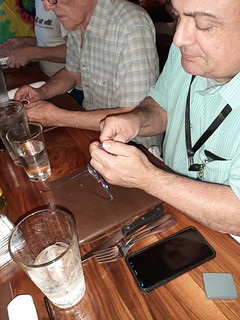 I didn't get a good photo of it, but Kellen arrived with a great icebreaker for the group. It was a steel-colored metal disc the size and shape of a hockey puck with a small handle in the middle of one side and an Eisenhower dollar showing through on the other side. The goal - seperate the two components of the puzzle, the outer ring and the central portion with the coin. He deftly showed us how he did it effortlessly (multiple times!) Several of us tried us including myself, Jon and Eric Schena (pictured in deep concentration, right). I was the last holdout and finally said the magic words - "I Give Up!" Kellen revealed the secret that once known, makes it effortless. Great puzzle! You too could buy one online.
I didn't get a good photo of it, but Kellen arrived with a great icebreaker for the group. It was a steel-colored metal disc the size and shape of a hockey puck with a small handle in the middle of one side and an Eisenhower dollar showing through on the other side. The goal - seperate the two components of the puzzle, the outer ring and the central portion with the coin. He deftly showed us how he did it effortlessly (multiple times!) Several of us tried us including myself, Jon and Eric Schena (pictured in deep concentration, right). I was the last holdout and finally said the magic words - "I Give Up!" Kellen revealed the secret that once known, makes it effortless. Great puzzle! You too could buy one online.
Later in the evening I got a photo of Kellen and Dave Schenkman - one of the newest and youngest writers for The Numismatist, together with one of the oldest (and most recognized with literary awards). Dave recently won the Carl Carlson award from the Medal Collectors of America. Congratulations! While Dave's a whiz researching and writing about tokens and medals, he's no slouch as a collector of U.S. and foreign. His displays for the evening included a beautiful unslabbed 1804 Columbian 8 escudos, an equally beautiful 1794 large cent, a Fugio cent, a Pine Tree shilling, and a 1770 Mexican 8 reales, all of which were slabbed AU. Nice!
Right, Clockwise from left: Kellen, Jon, Chris, Mike, Julian, Tom, Steve, Wayne Herndon, (Dave), Eric
Above, Clockwise from left: Wayne Herndon, Dave, Eric, Kellen, Jon (Chris)
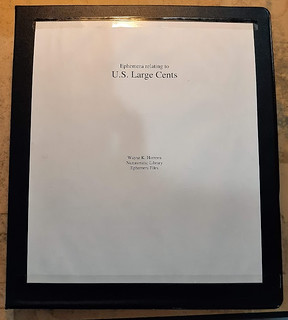 U.S. Large Cent Ephemera
U.S. Large Cent Ephemera
I have several (OK, about seventy) binders of numismatic ephemera in my library. I brought along two containing ephemera relating to U.S. Large Cents (and Half Cents, too). I took these photos today while drafting this article.
Jon's Medal Books
Jon Radel brought two great new books on medals. I took these photos at the dinner.
Steve's Beauties
Steve Bishop collects medals, plaques, Russian coppers and many other items, including toned silver dollars. He provided these images of some of the ones he shared with us at the dinner. Thanks.
Naglee's Brigade and Lovett's Baltimore Battle Monument Medals
"I brought to the dinner two newly acquired items I got at the ANA World's Fair of Money in Chicago and two related items that I have had (and shown) before. First is the very large and impressive Naglee's Brigade medal in bronze by Werley. It was made to commemorate the Battle of Fair Oaks on 31 May 1862 during the Peninsula campaign, one of which was given to Brig. Gen. Henry M. Naglee as a token of admiration.
This goes along with a previous purchase from an earlier ANA convention, the small soldier's medal awarded at Naglee's expense to members of his brigade for the same battle, though while our dinner was at Fair Oaks Mall, this Fair Oaks is outside of Sandston, east of Richmond."
"The second pair of items I brought was a silver Lovett Washington/Baltimore Battle Monument medal struck sometime around 1859, with a reported mintage of 25. This is a nice go-with
the Lovett Battle Monument die, which I also brought with me. All in all, these two items made my ANA convention."
It was another wonderful evening, one that I was delighted to share with our new neighbor Kellen. We all wish him the best of luck in his studies at George Washington University, and hope he can join us again sometime. And if anyone owns or has images of medals issued by GWU, please let us know - Kellen is beginning to catalog them.
I gave Kellen a lift to the Metro station where he could catch a ride back to campus. I joked about being the "old guy with glaucoma and cataracts driving in the dark" until I realized I'd been so engrossed in our conversation that I'd forgotten to put my headlights on. Aren't cars smart enough to do that themselves these days? Anyway, I got him there and we both made it home safely.
Thanks to everyone for sharing their information and images. 'Til next time!
To read the earlier E-Sylum article, see:
WAYNE'S NUMISMATIC DIARY: AUGUST 14, 2016
(https://www.coinbooks.org/esylum_v19n33a14.html)
EMPEROR JULIAN : ARTIFACTS OF APOSTASY
Austin Andrews of the American Numismatic Society published a Pocket Change article about the Roman emperor Julian. Here's an excerpt - see the complete article online for much more. -Editor
Historians and poets alike have all had their say about the quirks of the personality, reign, and life of the Roman emperor Julian (331–363 CE). To the late eighteenth-century historian Edward Gibbon, in his much-cited Decline and Fall of the Roman Empire, Julian was a doomed tragic hero; to the early twentieth-century poet C. P. Cavafy, he was snide, sharp, and cowardly; today, many contemporary scholars note how Julian snubbed what he saw as newfangled takes
on conventional wisdom. Julian's life is one that is at once well documented and widely studied, but, interestingly, poorly known to the general public.
Only a few decades prior to Julian's reign, his uncle, the emperor Constantine, adapted and legitimized Christianity on an imperial scale. In the wake of the succession hostilities that played out after Constantine's death, Julian came to power as one of the few survivors from his generation of the imperial family. Yet the Roman Empire, in the form of what historians retroactively call the Byzantine Empire, continued for another thousand years after Constantine's leadership. All of its subsequent emperors, at least in name, called themselves Christians after his example—with only one exception: Julian. His most famous coins are bronzes, which feature his bearded face on the obverse and an astral bull on the reverse (ANS 1944.100.22722, above). These are notable because, with the hindsight of history, they represent who Julian is as a historical figure most succinctly: a blip in a millennium of continuity.
As he reached adulthood, Julian had to present public reverence to the status quo and especially to his cousin Constantius, the reigning Augustus, or senior Roman emperor. This façade of goodwill manifested in Julian composing and delivering panegyrics—uncritical glorifying speeches—in honor of Constantius, as well as through presenting shared language and imagery on money and other media. Constantius was typically depicted on coins in the classic Constantinian style as on the solidus above: martially clean-shaven, his hair in a mullet with forward-combed bangs, and his head crowned with a pearly diadem (ANS 1944.100.22356). When Julian served as Caesar, or deputy emperor, under Constantius, his portraiture is nearly indistinguishable from that of the reigning Augustus without the diadem (e.g. ANS 1944.100.22357, below). At the behest of legionary soldiers in the province of Gaul, however, Julian eventually accepted the title of Augustus for himself. But before civil war began, Constantius died in the winter of 361 CE, naming Julian his successor.
At this point, Julian formally broke from Christianity. In private, he had not considered himself to be a Christian—or a Galilean
as he disparagingly termed Christians—for much of his adult life. As a result of his espousal of traditional polytheism flavored with cosmic philosophy, Julian is typically referred to with the epithet, the Apostate,
meaning that he intentionally abandoned the religion of his upbringing. His writings and his coinage, including the bronze bull issues, tell the story of his apostasy.
To read the complete article, see:
Artifacts of Apostasy
(https://numismatics.org/pocketchange/apostasy/)
THE FAMOUS CHINESE AUTO DOLLARS
A Stack's Bowers blog article by Jeremy Bostwick takes a look at the famed Chinese Auto Dollars.
-Editor
Among the many iconic and enigmatic designs found on world coins of the 20th century, it is hard to look past the famed Chinese Auto Dollar.
Dated to year 17 of the founding of the Republic (1928) and emanating from the province of Kweichow (an otherwise scant producer of coins), this design is a classic and offers seemingly timeless appeal. While the reverse merely conveys its denomination, metal, date, and issuing authority, the obverse features the main collecting objective—its automotive motif. According to Eduard Kann, author of the Illustrated Catalog of Chinese Coins (Gold, Silver, Nickel & Aluminum),
the type was struck to commemorate the completion of the Kweichow Provincial Highway, the first road for automobiles in the province.
What's more, Kann alleges that the car itself is a representation of the provincial governor, Zhou Xicheng (Chow His-chien). Kann even mentions that the numerous blades of grass in the field below the automobile could be a stylized depiction of the governor's name, with the grass blades paralleling the incised nature of earlier Chinese epigraphy (though this may be a bit fanciful). Nevertheless, their odd styling and manner of overlapping in spots does lead to the conclusion that they may indeed have a deeper meaning. Adding to the grassy intrigue, the type is found with two varieties—one with two small initial grass blades under the car's final tire, and one with with three small initial grass blades instead (the latter of these two variants being the scarcer and far less encountered).
Given the omnipresent nature of the automobile in our daily lives, the fact that this Auto Dollar
represents one of the earliest depictions within the world of numismatics should not be underappreciated. Its presentation on this immensely popular world crown continues to evoke the imagery of a bygone era and serves as a tangible timestamp to the period of its manufacture. As interest in Chinese numismatics continues to soar, this type seemingly serves as the pace car, leading the way as this field of numismatics shifts into yet a higher gear. Our fall Hong Kong auction will feature ten of these classic Kweichow Dollars, nine of which will be among the highlights in our Rarities Night. With grades that run the spectrum, it is assured that those seeking an example of this famed type will have much from which to choose, making this auction an event that simply should not be missed.
Interesting "grassy knoll" theory... -Editor
To read the complete lot descriptions, see:
The October 2022 Hong Kong Auction - Session E - Rarities Night - Lots 51001-51257
To read the complete article, see:
THE FAMOUS AUTO DOLLARS
OF THE KWEICHOW PROVINCE
(https://stacksbowers.com/the-famous-auto-dollars-of-the-kweichow-province/)
AUSTRALIA WATCHDOG INVESTIGATING PERTH MINT
Don Cleveland passed along this article about Australia's financial crimes watchdog's investigation of the Perth Mint. Thanks. -Editor
Australia's financial crimes authority, AUSTRAC, is investigating the state-owned Perth Mint in a move that could have wide-reaching ramifications, not only for the WA government, but also for taxpayers.
So what is the gold refiner suspected of doing wrong, and what's the possible fallout?
Many people assume the Perth Mint is little more than a tourist attraction or place where commemorative coins are created, but this is far from the full picture.
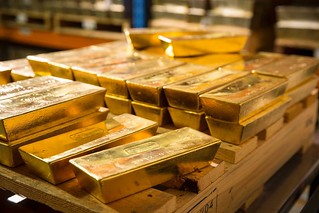 The Perth Mint is the world's largest producer of newly mined gold. It processes around 10 per cent of annual global gold production, and mints the vast majority of gold mined in Australia.
The Perth Mint is the world's largest producer of newly mined gold. It processes around 10 per cent of annual global gold production, and mints the vast majority of gold mined in Australia.
The Perth Mint's foundations are steeped in WA's gold rush history. It was created at a time when currencies were backed by gold, and mining the precious resource was key to powering Australia's economic growth. But the "gold standard", as it was known, was abandoned globally in the early 1970s.
Thomson Reuters Asia Pacific financial crime expert Nathan Lynch said these days the justification for the state underwriting the mint was "really thin".
"When this was set up the mint wasn't running a massive, commercial safe deposit box," he said.
"I mean, it's the biggest primary producer of mined gold in the world, it's sitting on $6 billion of gold. And if any of that gold goes missing, or is stolen, it has to be paid for by who? Taxpayers."
Technological advances have allowed the mint to reach clients around the world, through an app called GoldPass.
The app allows anyone to trade gold and silver digital certificates — certificates that are backed by physical Perth Mint gold/silver stored in its central bank-grade vaults.
The app also allows investors to choose whether they trade in Australian or US dollars — which could also expose the mint to US regulators, as well as AUSTRAC.
To read the complete article, see:
Why is Australia's financial crimes watchdog investigating the Perth Mint?
(https://www.abc.net.au/news/2022-09-19/austrac-investigates-perth-mint/101438128)
AUSTRALIAN COIN AND BANKNOTE RISKS
Don Cleveland also passed along this article about risks to Australian coin and banknote production. Thank you. -Editor
Don writes:
"Since the Queen's passing, there has been a flood of articles in the press about changes to Australia's coins and currency. Some interesting insights into minting and printing money in this article."
Briefly, in the days after the death of the Queen, we were afforded a glimpse into the machine that makes Australia's money.
Assistant Treasury Minister Andrew Leigh turned up at the Royal Australian Mint to explain the process by which a portrait of the King Charles will replace the portrait of the queen on the heads-side of coins minted from 2023.
(And yes, he noted "for the avoidance of doubt, for any conspiracy theorists out there, all coins bearing the face of Queen Elizabeth II will remain legal tender".)
The Mint makes an extraordinary 120 million to 140 million coins per year (even more, as much as 175 million when Australians stocked up on cash during the first year of COVID), and it is a money-making operation in more ways than one.
Usually it costs the Mint far less to make each coin than each one becomes worth the moment it is sold to a bank (before metal prices climbed, it cost the mint about 20 cents to make a $2 coin, and about 15 cents to make a 50 cent coin).
The profit — the huge mark-up — goes straight to the Commonwealth budget as non-taxation revenue, tens of millions per year. It's called "seigniorage" an ancient French word that refers to the profit only a seignior (feudal lord) can make from the exclusive right to mint coins.
This financial year the government expects $59 million, next year $67 million.
In 2020-21 Note Printing Australia delivered 234 million notes to the bank for a fee of $74 million, suggesting they cost about 32 cents each to make. Most were $50 and $100 notes, sold to private banks for $50 and $100 each.
That profit is accounted for differently to the profit for coins, and is hard to find.
One estimate, in an international study of 90 countries at the end of the 1990s, found Australia's income from seigniorage of notes and coins to be low compared to other countries at 2.6 per cent of government spending.
But 2.6 per cent is an enormous amount. These days that'd be $16.3 billion, which is about what we spend on the Pharmaceutical Benefits Scheme.
In 2016 the Mint developed a proposal to cheapen the metal content of its five, ten and 20 cent coins and shrink the size of its 50 cent coins, which it says was favourably received by retailers and banks who wanted coins that weighed less. The idea was submitted to the Treasury, but "not progressed".
In the meantime it has partnered with Woolworths to produce limited edition "Olympic" and "Wiggles" coins that are delivered as change through cash registers rather than through banks, for which it charges a touch over $2.
There's a lot that can be done, and every time there's a crisis, we seem to re-discover cash. But eventually the money making machine will stop.
To read the complete article, see:
The Mint and Note Printing Australia make billions for this country – but it could be at risk
(https://www.abc.net.au/news/2022-09-21/the-mint-printing-money-why-cash-won-t-last-forever/101458918)
DONEGAL WAR HERO'S LOST MEDAL FOUND
By way of Donegal, Ireland comes this story of a U.S. sailor's lost (and found) Purple Heart. -Editor
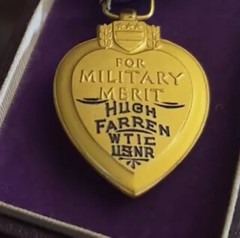 The mystery of a fallen US sailor's war medal has been traced all the way to Inishowen in Donegal, 80 years after it was lost.
The mystery of a fallen US sailor's war medal has been traced all the way to Inishowen in Donegal, 80 years after it was lost.
Hugh Farren, the owner of Farren's Bar in Malin, is reeling with the news today that his grand-uncle's military honour has been found through the power of social media.
Hugh's namesake, Hugh Farren, was killed in action while serving with the US Navy during WWII. Farren had immigrated to Boston as a young man and worked as a city firefighter. When the war broke out, he enlisted with the Navy and was serving as a water tender on the aircraft carrier, the USS Liscome Bay, when it was sunk by a Japanese torpedo on Thanksgiving 1943. He was 39 years old.
Farren was posthumously honoured with a Purple Heart medal – a prestigious decoration awarded to those wounded in war or to the family of those who paid the ultimate sacrifice. It's believed that Farren's medal was given to his sister, Ellen, who he lived with in Dorchester.
However, Farren's medal was lost long ago, and despite efforts by his brothers to trace its journey, it was never recovered. Until recently.
The medal was found last week in the home of a former Attleboro firefighter who is now in hospice care. The Purple Heart was passed on to local Veterans Services Director Ben Quelle who launched the search for its rightful owners.
Ben's news appeals quickly reached across the Atlantic to Donegal. Hugh Farren in Malin and Denis Doherty, the grandson of Ellen, soon reached out to Ben to confirm the lineage.
It's amazing that 80 years later, we are talking about Hugh,
Farren's grand-nephew Hugh told Donegal Daily.
A footbridge in Boston is named after Hugh Farren, and his name has been carried through the Farren family to remember their lost brother.
Now that the search has come full circle, Boston media reports that Farren's descendants will be eligible for the Massachusetts Medal of Liberty which is awarded to surviving family members of men and women killed in action.
Hugh, who has always intended to visit the bridge in Boston, said that the Liberty Medal could be a good opportunity for all the cousins to meet and celebrate the fallen soldier once more.
To read the complete article, see:
DONEGAL WAR HERO'S LOST MEDAL FOUND AFTER INCREDIBLE 80 YEARS
(https://www.donegaldaily.com/2022/09/23/donegal-war-heros-lost-medal-found-after-incredible-80-years/)
ELTON JOHN RECEIVES HUMANITIES MEDAL
Singer Elton John was awarded a national humanities medal this week. -Editor
British singer Elton John was left teary-eyed and flabbergasted
after being awarded a surprise national humanities medal by President Biden, following a concert at the White House on Friday night.
John, 75, who was born Reginald Kenneth Dwight, is a world-renowned singer, pianist and songwriter. He has also championed numerous charities and humanitarian causes, especially those tackling HIV/AIDS.
Flanked by the president and first lady, John, wearing his signature red-tinted spectacles, looked visibly shocked as he first spotted the medal, covering his face with his hands in disbelief.
I'm never flabbergasted, but I'm flabbergasted and humbled and honored by this incredible award from the United States of America,
he said, overcome, moments after clutching Jill Biden's hand and hugging her husband. I will treasure this so much.
The Grammy-winning singer praised America's kindness to me as a musician,
calling it second to none,
and vowed that the medal would push him to redouble his efforts to help eradicate the illness that impacts more than 38 million people globally, according to the World Health Organization.
The concert on the South Lawn, titled A Night When Hope and History Rhyme,
was part of his farewell tour after a glittering 50-year career. It was also an event to honor everyday history-makers in the audience,
according to the White House, among them teachers, military families and LGBT+ advocates.
John dedicated Don't Let the Sun Go Down on Me
to Ryan White and his mother, Jeanne White-Ginder, who attended the concert. Her son lost his life to AIDS-related complications after a blood transfusion and died in 1990, just a month before his high school graduation.
The legendary singer launched the Elton John AIDS Foundation in 1992, which has raised over $450 million and funded programs across four continents. In between songs, John spoke to the audience about his hope to help eradicate the virus by 2030.
His medal from Biden will sit alongside his Legion d'Honneur, given to him by French President Emmanuel Macron in 2019.
To read the complete article, see:
Elton John ‘flabbergasted' and teary after Biden surprises him with medal
(https://www.washingtonpost.com/lifestyle/2022/09/24/elton-john-medal-biden-white-house/)
To read the earlier E-Sylum article, see:
AAS ACCEPTS NATIONAL HUMANITIES MEDAL
(https://www.coinbooks.org/esylum_v17n36a19.html)
THE BOOK BAZARRE
This book will inspire you to begin a richly satisfying lifelong journey.160 pages, coffee-table, fully illustrated. Order your copy online at Whitman.com , or call 1-800-546-2995.
AN ALTERED NORTH AFRICA NOTE
An article in the September 24, 2022 MPC Gram (Series 23 No. 2541) by Larry Smulczenski discusses altered North Africa silver certificates. It is republished here with permission. Thanks! -Editor
An Altered North Africa Note
Just like the Hawaii notes that were issued after the Japanese raid on Pearl Harbor in case a ground attack followed and U.S. currency needed to be declared invalid should it fall into the hands of the invaders, a similar issue of silver certificates was issued for Operation Torch, the invasion of North Africa. These notes were also used for the invasion of Sicily. The only identifying feature of these notes was that the blue seal of a silver certificate was changed to a yellow seal. As is common in any conflict on foreign shores that involve American troops, U.S. currency finds its way into the local economy.
When it became known that the North Africa notes could possibly be demonetized at any time, either during or after the conflict, some of the local holders became concerned that they could be left with worthless notes. Someone came up with the scheme to convert the North Africa ten dollar note to a current Federal Reserve note. This involved changing the seal from yellow to green, the serial numbers from blue to green, replacing the large blue 10
with the black New York Federal Reserve seal, changing the position of the legal tender clause and adding the New York district numbers in the four corners of the note. No attempt was made to change the "Silver Certificate" title at the top of the note.
An error was made in the development of the New York seal where the N
of New York has the diagonal line printed from upper right to lower left instead of the correct upper left to lower right orientation. This seems like a stupid mistake for a craftsman to make who did such good work on the rest of the alteration. Remember, however, that there are countries across the Adriatic Sea that use the Cyrillic alphabet and people do migrate. It could be that the designer of the alteration had a Cyrillic background and in a senior moment
reverted to the Cyrillic alphabet where there is a letter that looks exactly like the backwards N.
I have never heard that argument before, but I believe it has merit. If you have an opinion, I would like to hear it.
I bought one of these notes at a Memphis Paper Money Show many, many years ago. I remember walking around and showing it off like a proud Papa showing a picture of his new offspring to anyone who would take the time to look and listen. It generated a lot of looks but one person who exhibited keen interest in the note and the subject of the North Africa notes, was a fellow by the name of Bill Doovas.
Fred [Schwan] and I went to a lecture, the subject of which I do not remember, but Bill went with us. Before he went to the lecture, Bill bought a North Africa $10 note on the bourse floor. While Fred and I sat there and paid attention to the presentation, Bill sat over to the side and rubbed on that North Africa note with a plain yellow wooden pencil with a red rubber eraser on top. The lecture lasted 30 or 40 minute. During that time Bill had erased the blue serial numbers, the large blue 10
and legal tender clause on the left and 90% of the yellow seal on the right. He wanted to prove that the ink on the North Africa note could be removed without damaging the note.
I can tell you there were no scratches on the note, no thin spots, and other then a trace of yellow, no remaining colors of the removed parts. I am not saving this is the way it was done, but I will say that Bill proved that the ink would come off and the alteration could be made. Bill then offered me that note that he worked on for the amount that he paid for it and I gladly bought it from him. As I remember it was only $20. You can see it at the bottom of this page. Pictured are a North Africa note, the Doovis erasure, the altered North Africa note and a New York Treasury note for comparison.
The MPC Gram is an email newsletter for collectors of Military Payment Certificates and other military numismatica. To subscribe to the MPC Gram, see: https://guide.us13.list-manage.com/subscribe?u=10eb366ab80344a56657e0d5d&id=58874b37e1 . -Editor
THE PEOPLE'S MONEY
Here are a couple interesting satire notes in the October 15, 2022 Holabird sale. I don't believe we've discussed these before. -Editor
Two notes issued by Dennis Kearney and Benjamin F. Butler satirizing legal tender. One Hundred Dollars "absolute money", in nothing , at no time, and by nobody, series of 1878. Vignettes of both Kearney and Butler, some tears around the edges. Second note is 1000 dollars of absolute irredeemable money. EF-AU condition. Butler parlayed his victory in the 1882 Juilliard v. Greenman decision (allowing government to issue paper money) into a run for president in 1884. Butler was nominated by the Greenback and Anti-Monopoly parties, but lost to Grover Cleveland.
To read the complete lot description, see:
The People's Money [156117]
(https://www.icollector.com/The-People-s-Money-156117_i46434392)
LOOSE CHANGE: SEPTEMBER 25, 2022
Here are some additional items in the media this week that may be of interest. -Editor
100% Undetectable Counterfeit Money Online
I was too chicken to click on this Google Alert - Lord knows what kinds of ads would stalk me around the web. But hey, why not get some and deposit it at an ATM? It's undetectable, so it wouldn't matter that I'm using my own card and account and my face is on a security camera video... -Editor
And in the seems-like-a-fair-trade-to-me department, a gentleman in Southgate, Michigan attempted to purchase lottery tickets with counterfeit money. -Editor
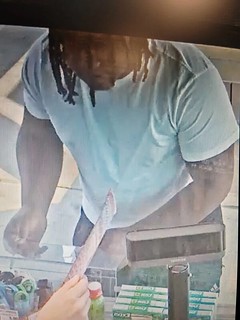 The Southgate Police Department is hoping to identify a man seen on surveillance cameras at the Kroger Fuel Center who allegedly offered counterfeit cash to buy lottery tickets.
The Southgate Police Department is hoping to identify a man seen on surveillance cameras at the Kroger Fuel Center who allegedly offered counterfeit cash to buy lottery tickets.
We would like to explain to him that it is necessary to use actual currency when making purchases,
a post on the department's social media page said.
According to Detective Lt. Michael Murphy, the man passed eight counterfeit twenty dollar bills.
To read the complete article, see:
Man uses counterfeit cash to buy lottery tickets for chance to win real big bucks
(https://www.thenewsherald.com/2022/09/23/man-uses-counterfeit-cash-to-buy-lottery-tickets-for-chance-to-win-real-big-bucks/)
Collectors love bargain-hunting. Here's a story about a medieval manuscript page linked to William Randolph Hearst. -Editor
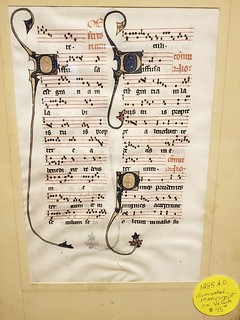 A bargain hunter who went to an estate sale in Maine to find a KitchenAid mixer, a bookshelf or vintage clothing walked away with a 700-year-old treasure.
A bargain hunter who went to an estate sale in Maine to find a KitchenAid mixer, a bookshelf or vintage clothing walked away with a 700-year-old treasure.
Instead of a kitchen appliance, Will Sideri stumbled upon a framed document hanging on a wall. It had elaborate script in Latin, along with musical notes and gold flourishes. A sticker said 1285 AD. Based on what he'd seen in a manuscripts class at Colby College, the document looked downright medieval.
And it was a bargain at $75.
Academics confirmed the parchment was from The Beauvais Missal, used in the Beauvais Cathedral in France, and dated to the late 13th century. It was used about 700 years ago in Roman Catholic worship, they said.
An expert on manuscripts said the document, first reported by the Maine Monitor, could be worth as much as $10,000.
To read the complete article, see:
He went to an estate sale for bargains. He found a valuable 700-year-old document
(https://www.npr.org/2022/09/23/1124771471/estate-sale-700-year-old-document-france)
FEATURED WEBSITE: NAUTICAL NUMISMATICS
This week's Featured Web Site is Nautical Numismatics - watercraft depicted on banknotes, coins, and other fiscal materials.
Welcome to Nautical Numismatics ... a museum and marketplace honoring the importance of watercraft in the development of North America, as depicted in the art of currency and coin. Before there were roads, before there were rails, there were oceans, rivers, lakes, canals and locks. Watercraft of all kinds — clipper ships, paddle-wheelers, canal barges, canoes paddled by Native Americans and French voyageurs, and even Huck Finn rafts, sailed these waters to open the continent. From 1804 to 1806, Lewis and Clark sailed upstream the Missouri, then downstream the Snake and the Columbia – and a dozen other rivers in between – opening the West.
Then the Erie Canal (1825) opened the Atlantic to the Great Lakes and beyond. Many of the vignettes in our collection show Native Americans watching with consternation while a ship or a railroad penetrated their lands. With the coming of the railroads the importance of waterways was slowly eclipsed.
We tend to think the 21st century is changing everything, faster than ever. But just imagine yourself back in those early days of our country – the times they were a-changin', faster than ever. The aesthetic beauty and romantic legacy of the watercraft that brought those fast changes is preserved in these historical artifacts. Enjoy!
http://nauticalnumismatics.com/
Found via News & Notes from the Society of Paper Money Collectors (Volume VIII, Number 14, September 20, 2022) -Editor

